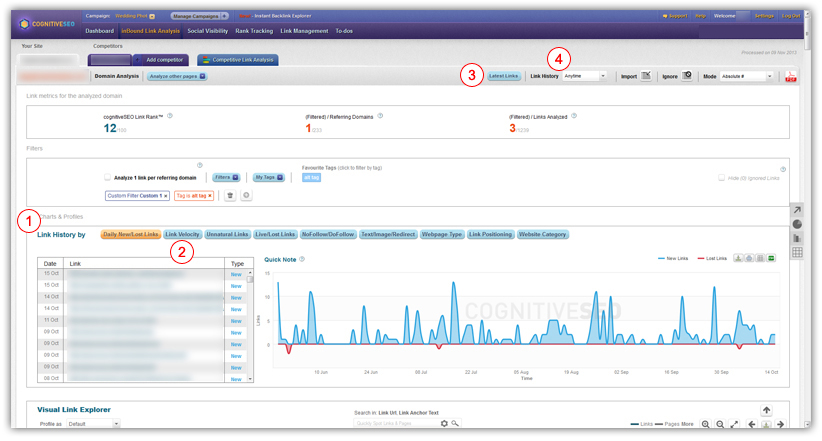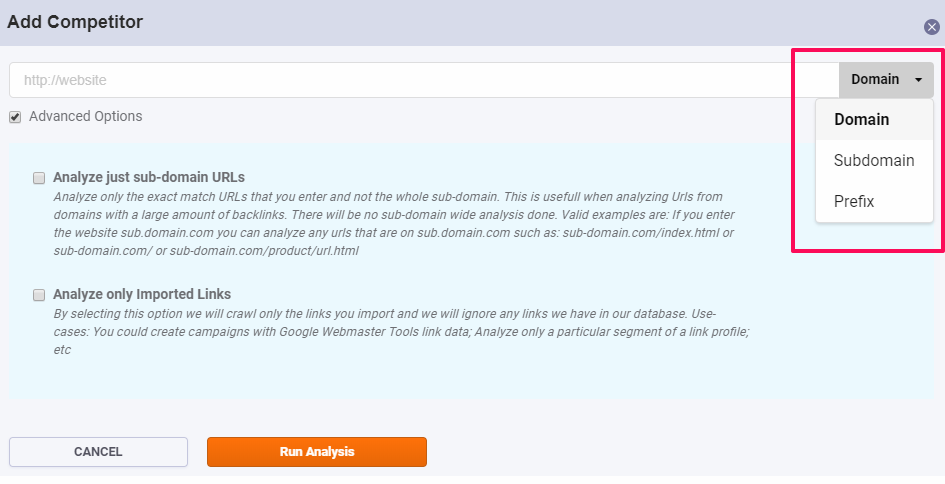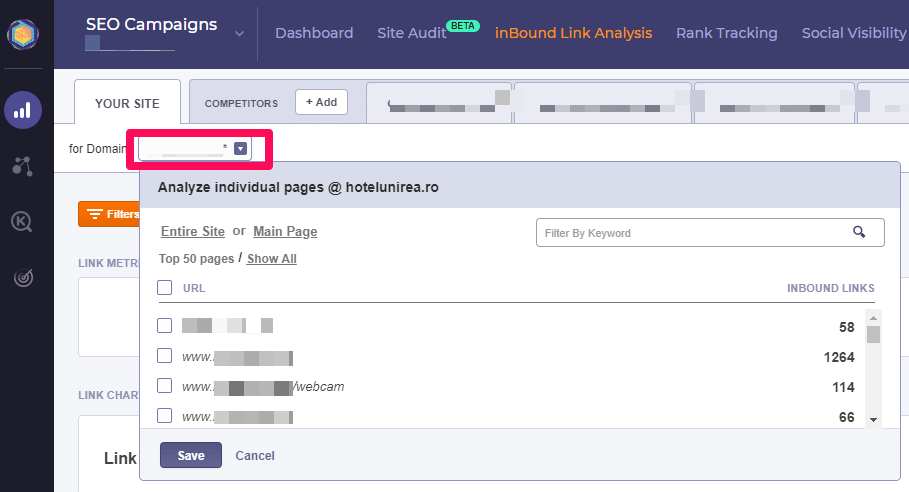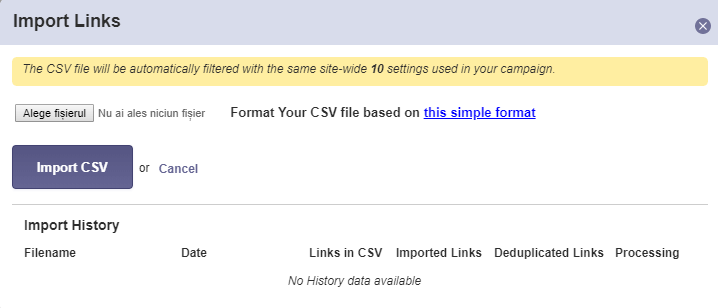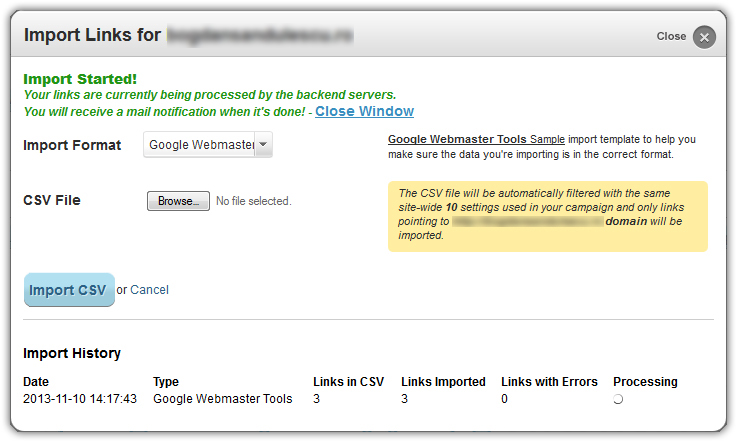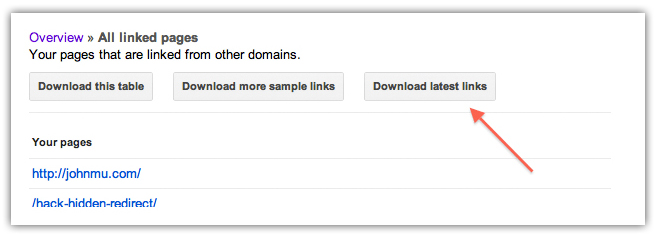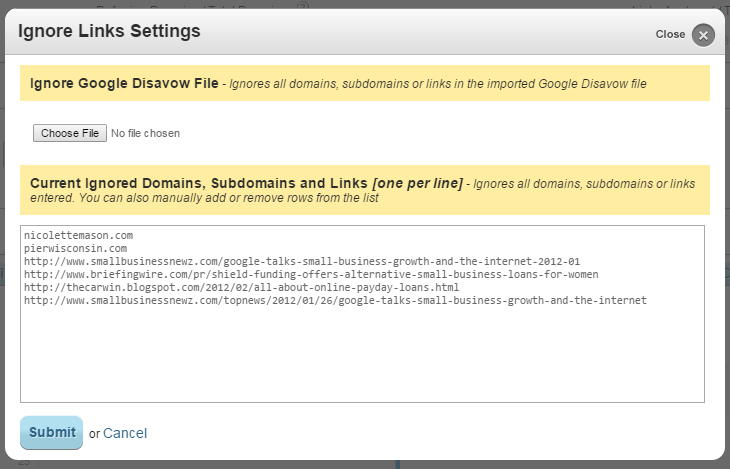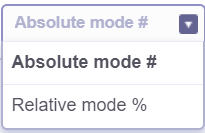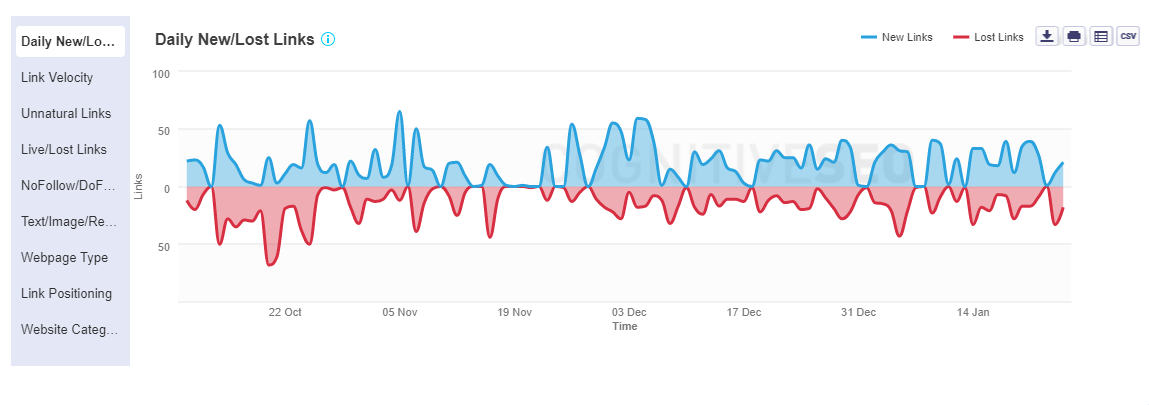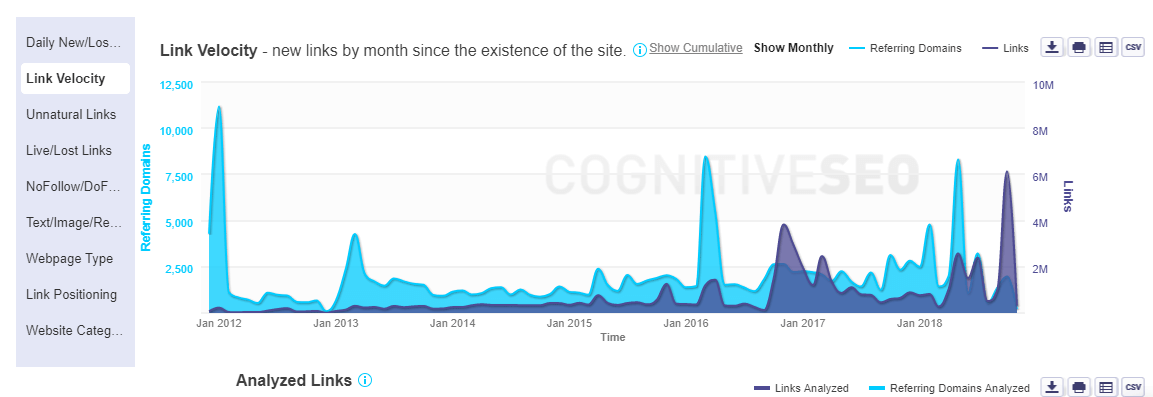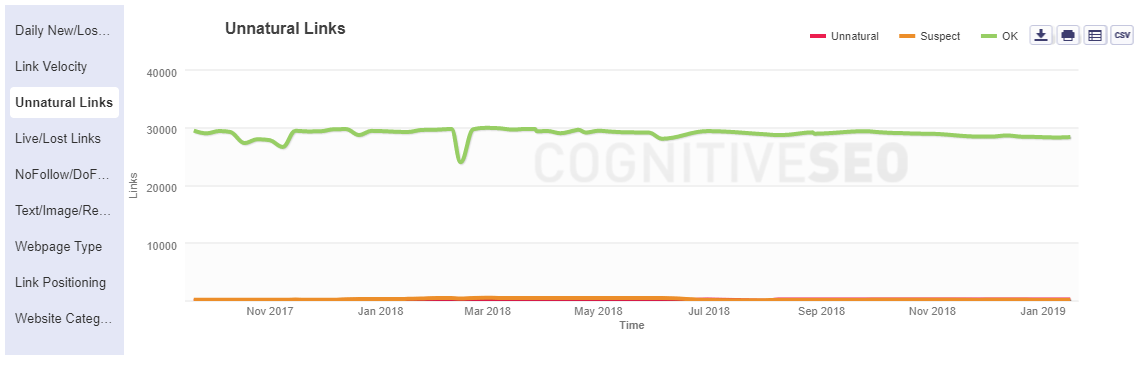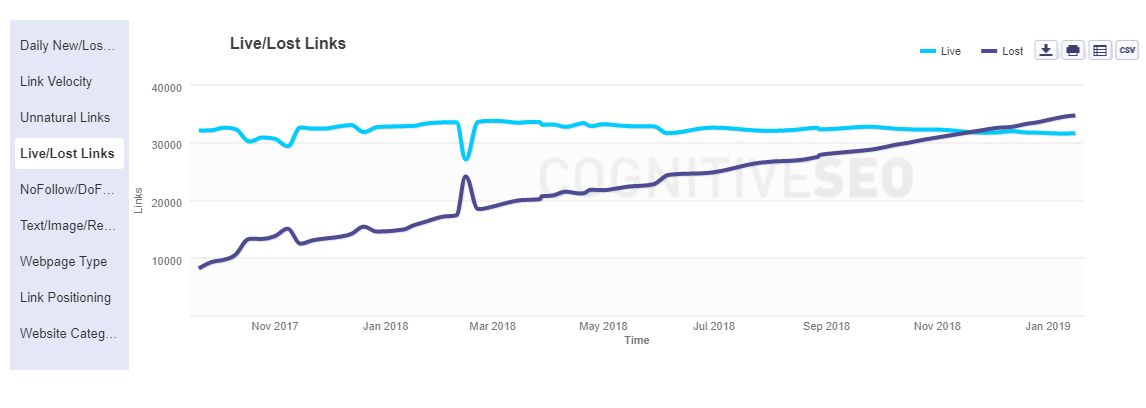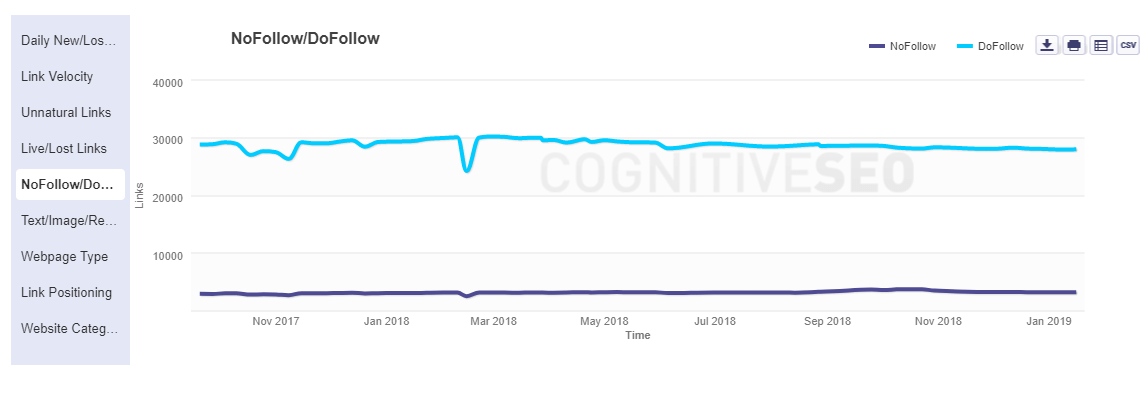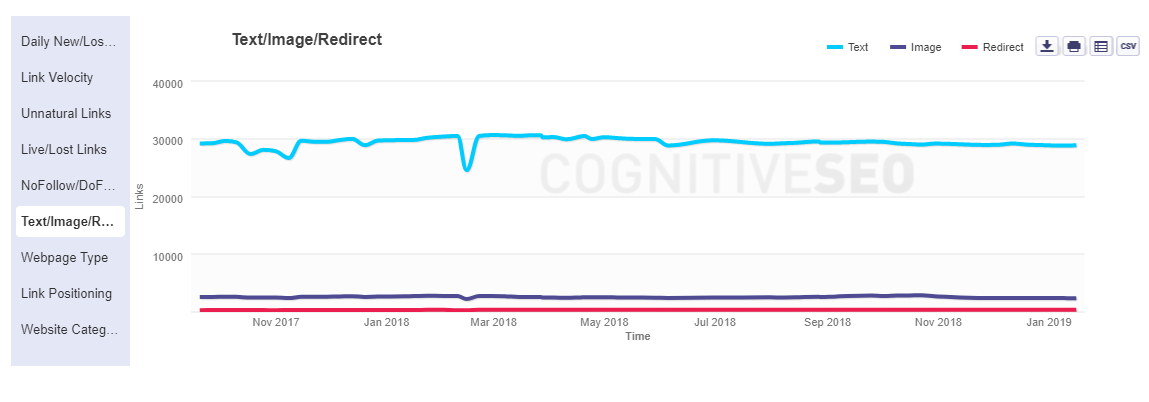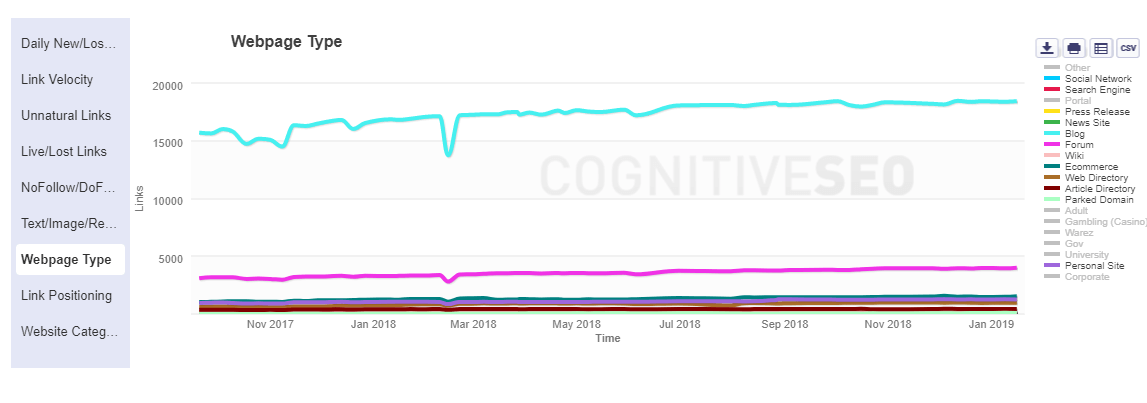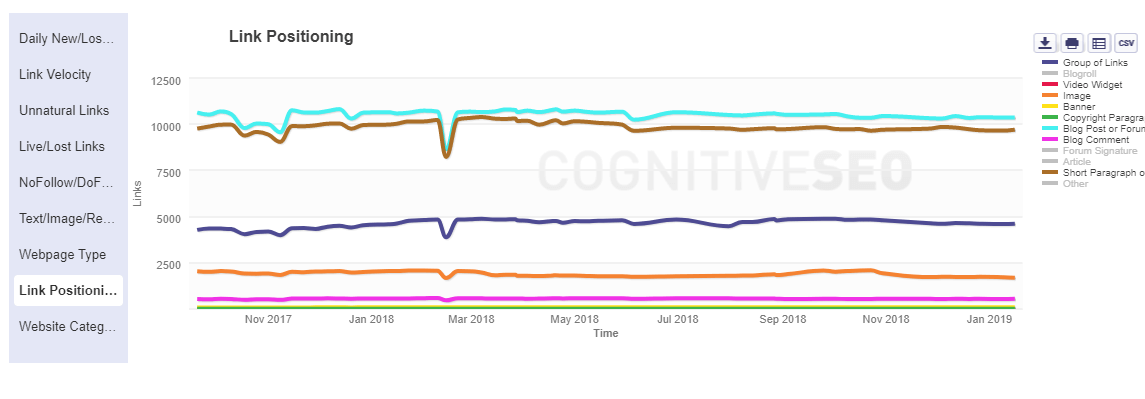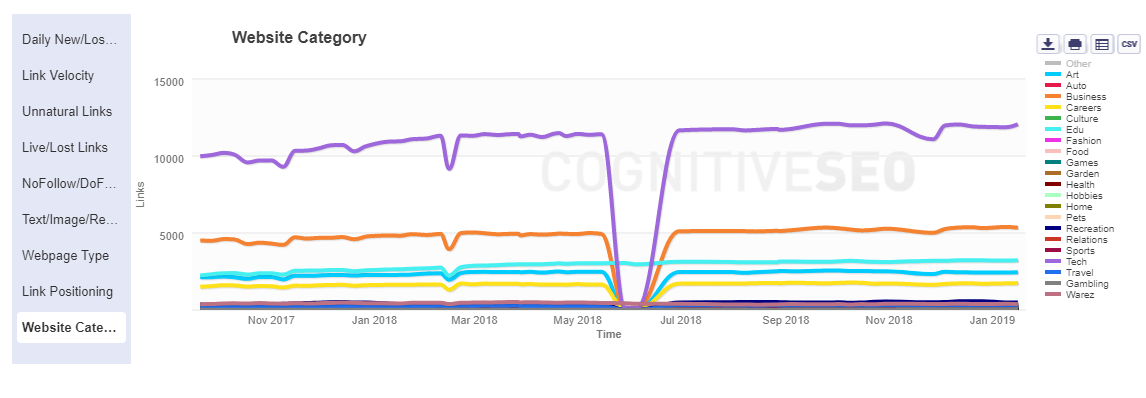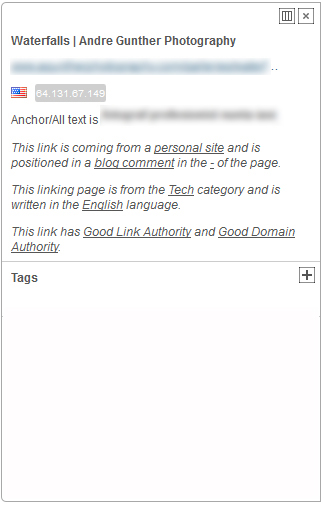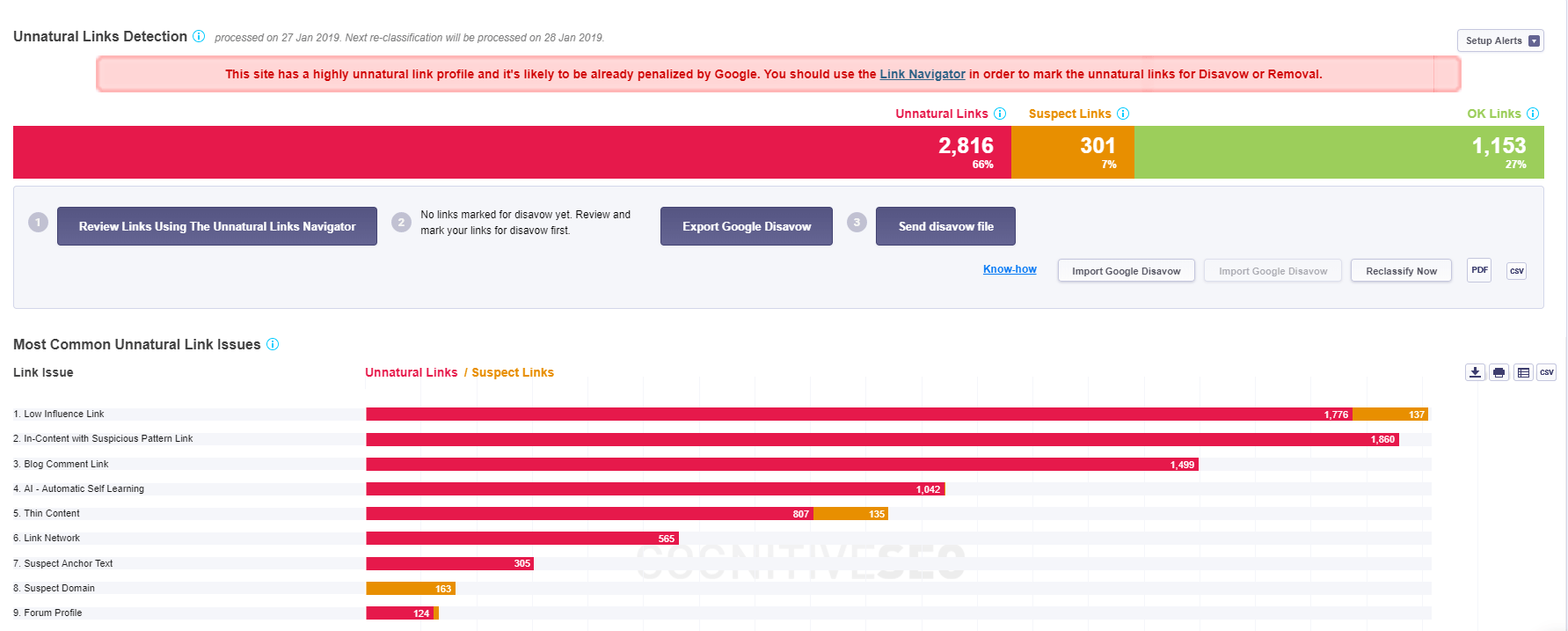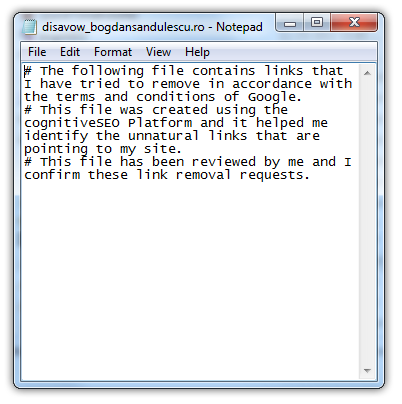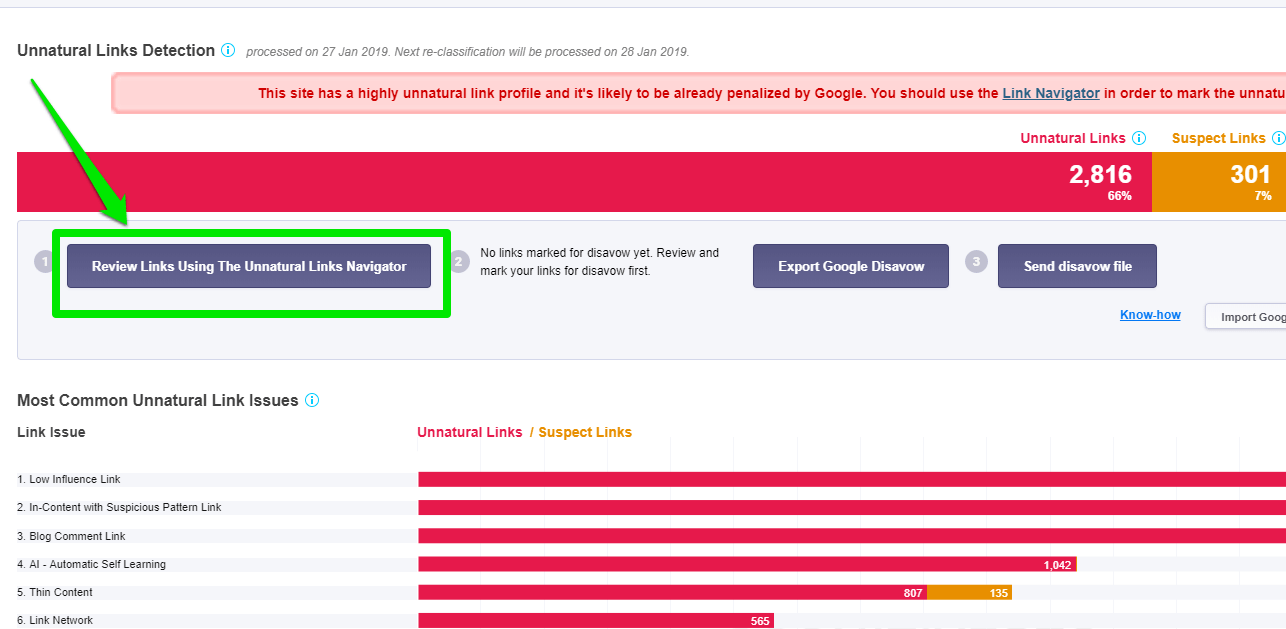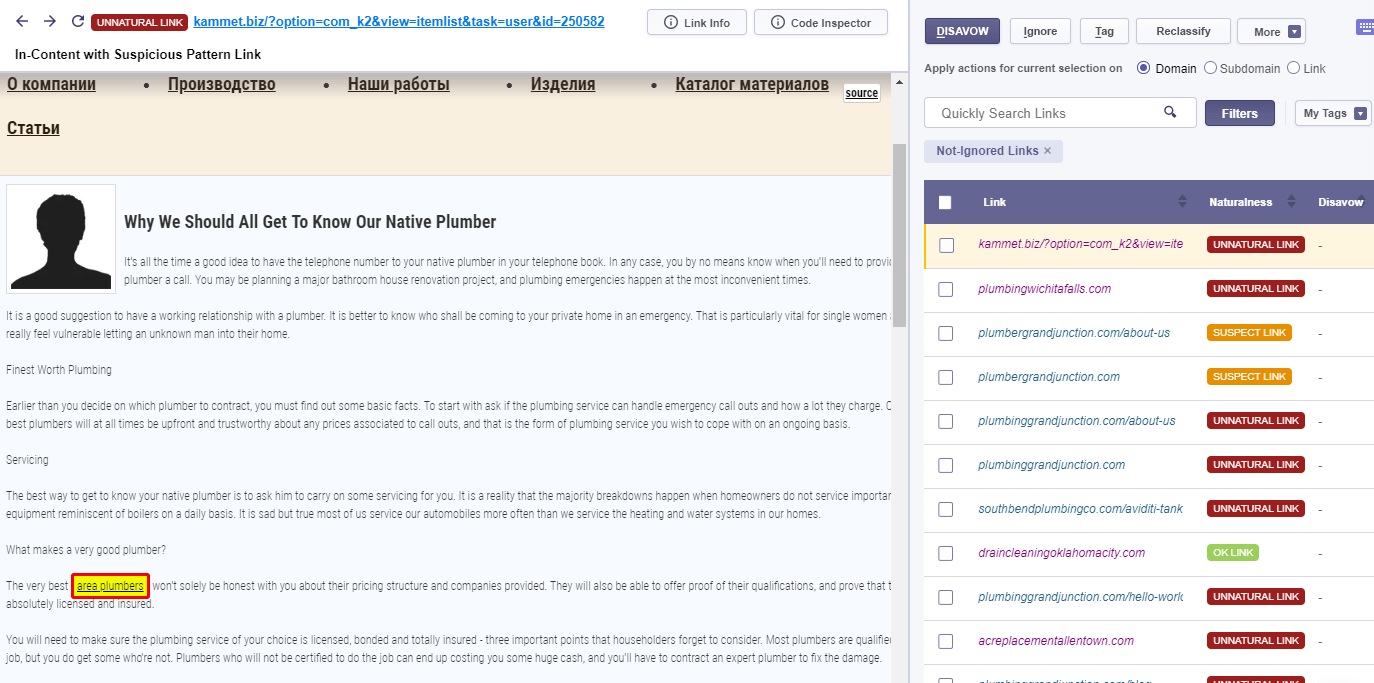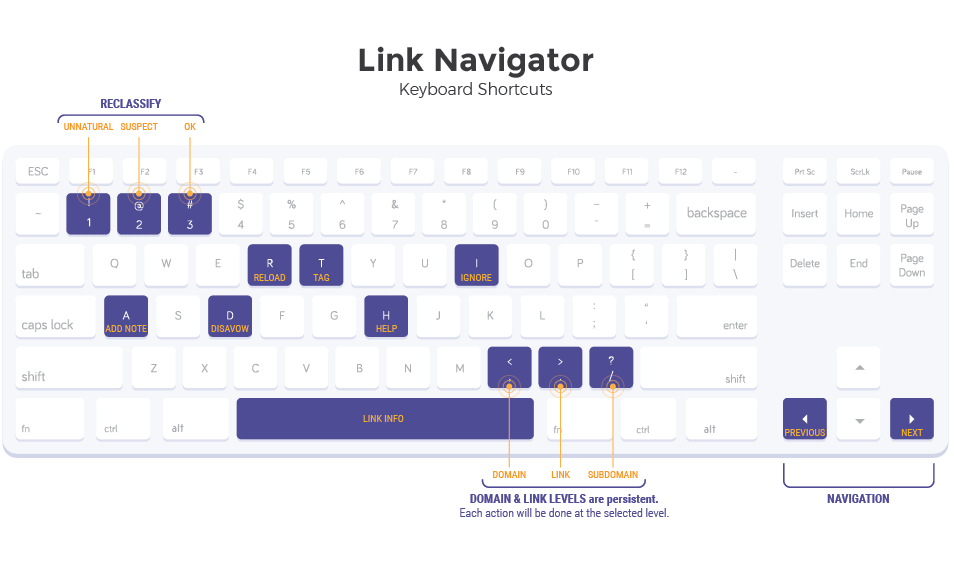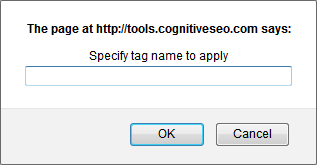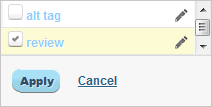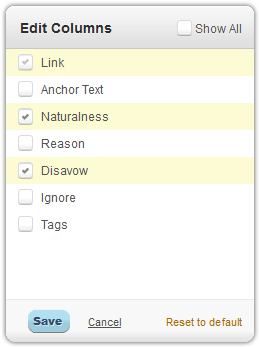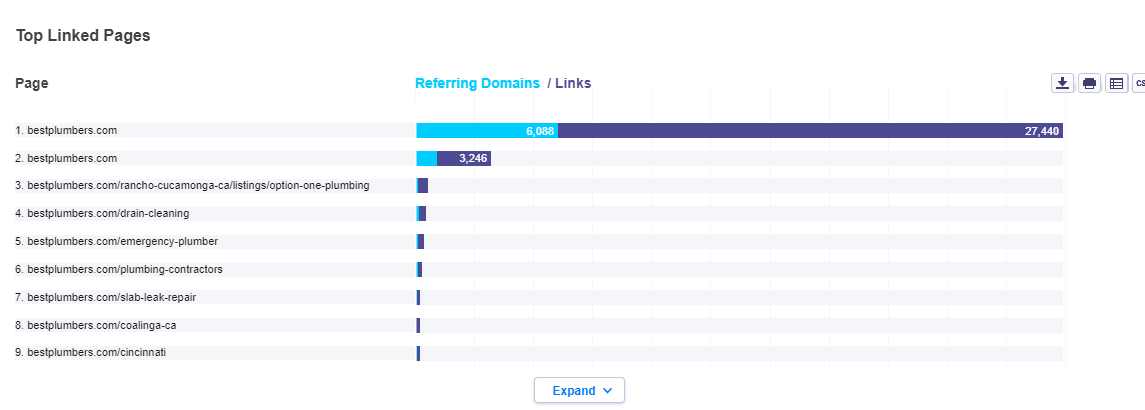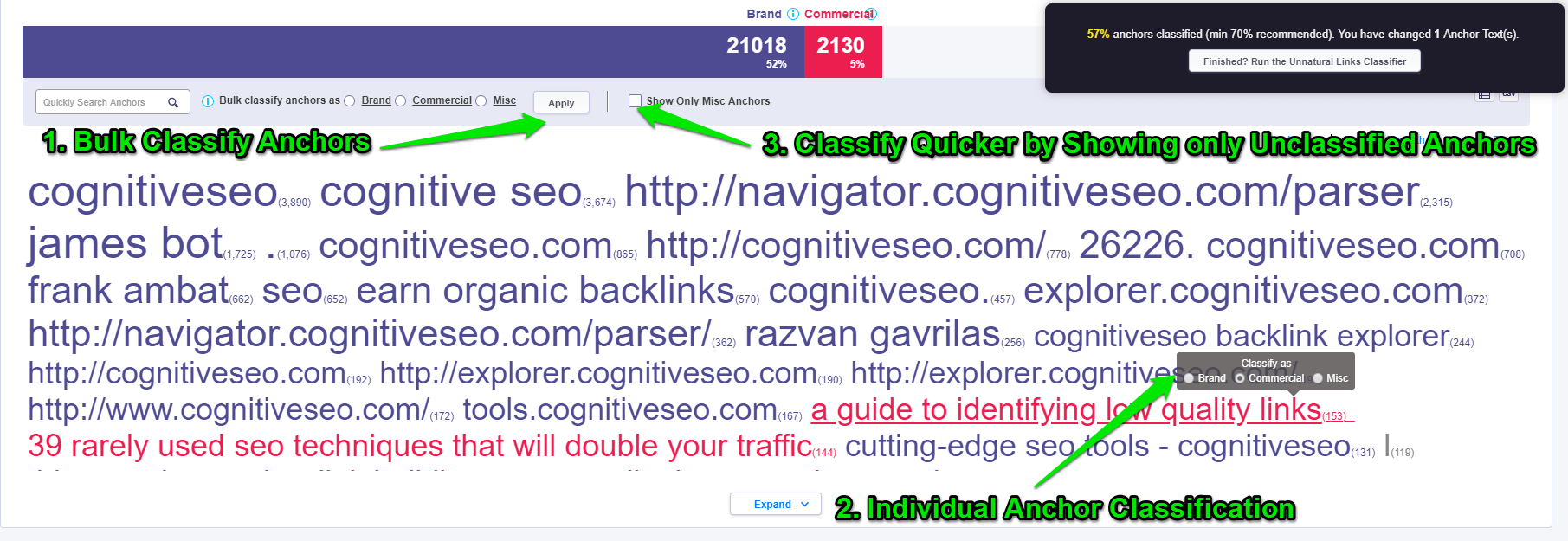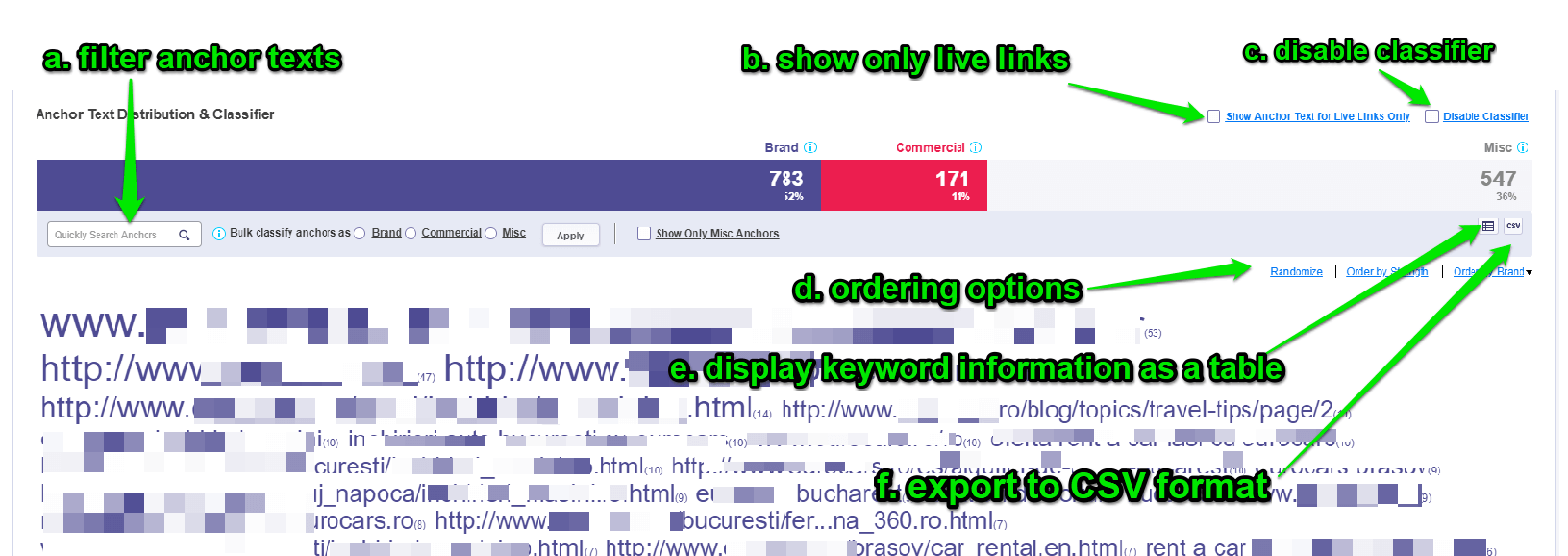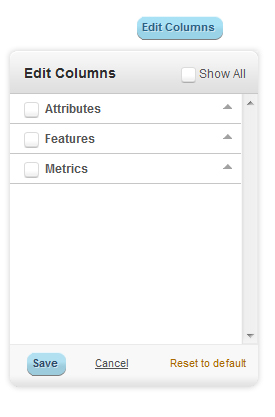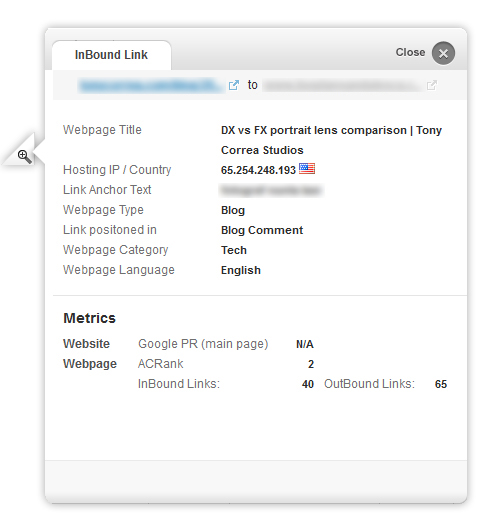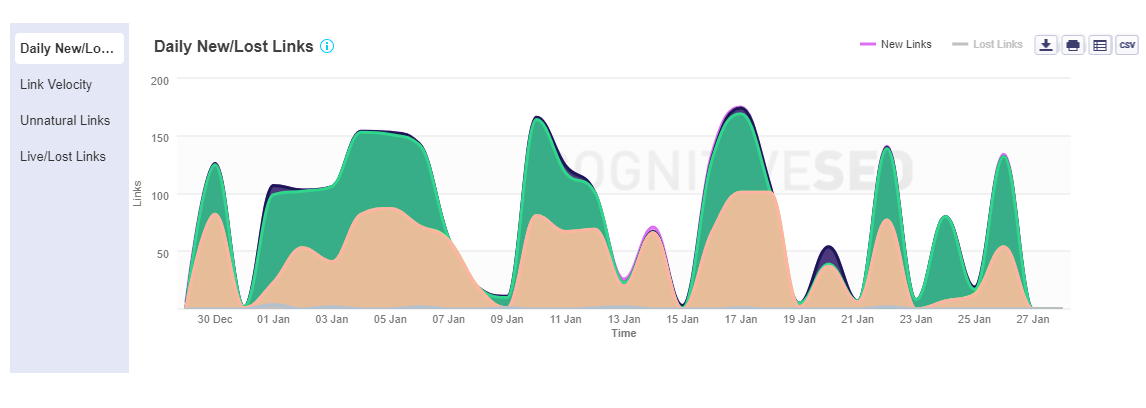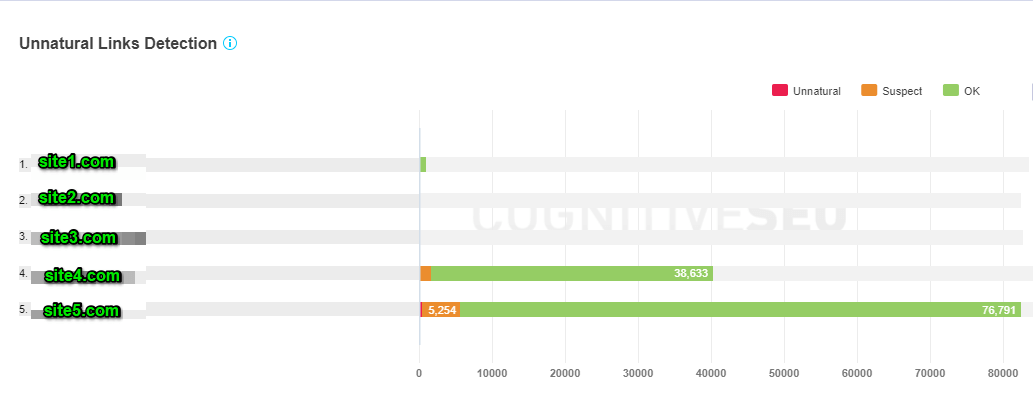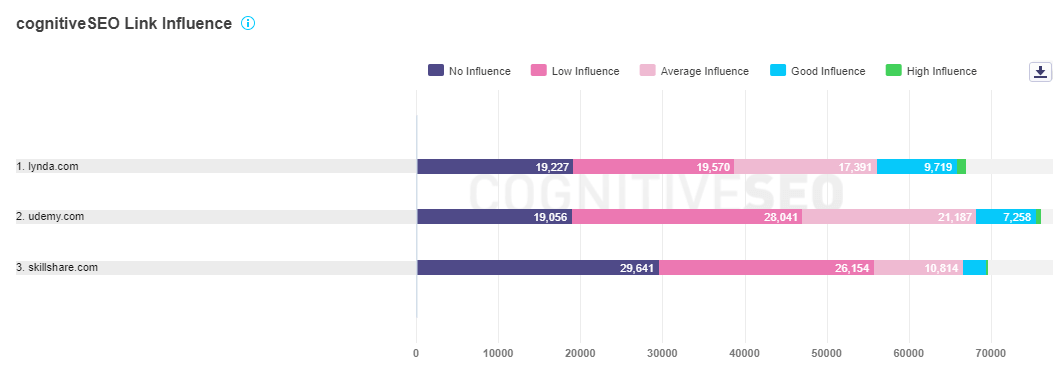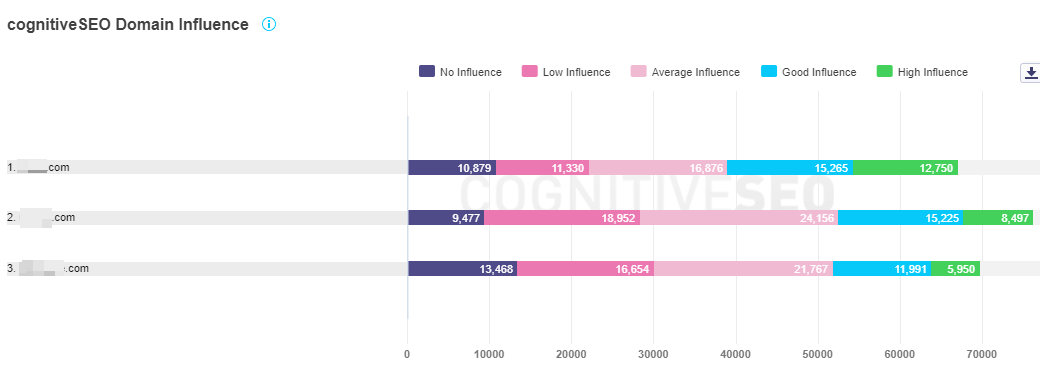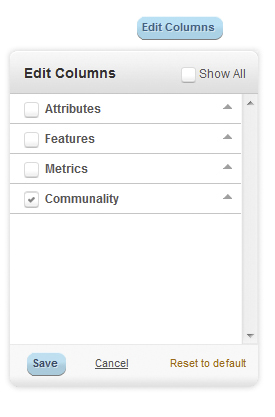Table of Contents
- Add Competitor
- Analyze Other Pages
- Latest Links
- Link History
- Import
- Ignore
- Mode
- Link Metrics Area
- Filters
- Link Charts and Profiles
- Link History By
- Link Velocity
- Unnatural Links
- Live Lost Links
- NoFollow/DoFollow
- Text/Image/Redirect
- Webpage Type
- Link Positioning
- Website Category
- Visual Link Explorer
- Unnatural Links Detection
- Top Linked Pages
- Anchor Text History By
- Anchor Text Distribution
- Link Influence Chart
- Domain Influence Chart
- Link Status Chart
- No Follow vs. Do Follow Chart
- Text/Image/Redirect Links
- Site Wide Links
- In-content Links
- Anchor Target
- Top 10 Referring IPs
- Top 10 Referring Countries
- Top Ten Class-C Referring IPs
- Deep Link Ratio
- Deep Backlink Ratio
- Webpage Type
- Link Positioning
- Link Visibility
- Webpage Category
- Webpage Language
- Domain TLD Distribution
- Links Trustworthiness
- Domain Trustworthiness
- Google Page Rank
- Webpage ACRank
- External Inbound Links
- Outbound Links
- Data Table
- Site by Site Comparison
- Link Charts & Profiles
- Link History By
- Link Velocity
- Unnatural Links
- Live Lost Links
- Unnatural Links Detection
- Brand vs. Commercial Anchor Text Distribution
- Anchor Text Distribution
- Referring IPs vs. Referring Domains vs. Links
- Common Links
- Common Domains
- Common IPs
- Link Influence Chart
- Domain Influence Chart
- Link Status Chart
- No Follow vs. Do Follow Chart
- Text/Image/Redirect Links
- Site Wide Links
- In-content Links
- Anchor Target
- Top Referring Countries
- Deep Link Ratio
- Deep Backlink Ratio
- Webpage Type
- Link Positioning
- Link Visibility
- Webpage Category
- Webpage Language
- Domain TLD Distribution
- Links Trustworthiness
- Domain Trustworthiness
- Google Page Rank
- Webpage ACRank
- External Inbound Links
- Outbound Links
- Data Table
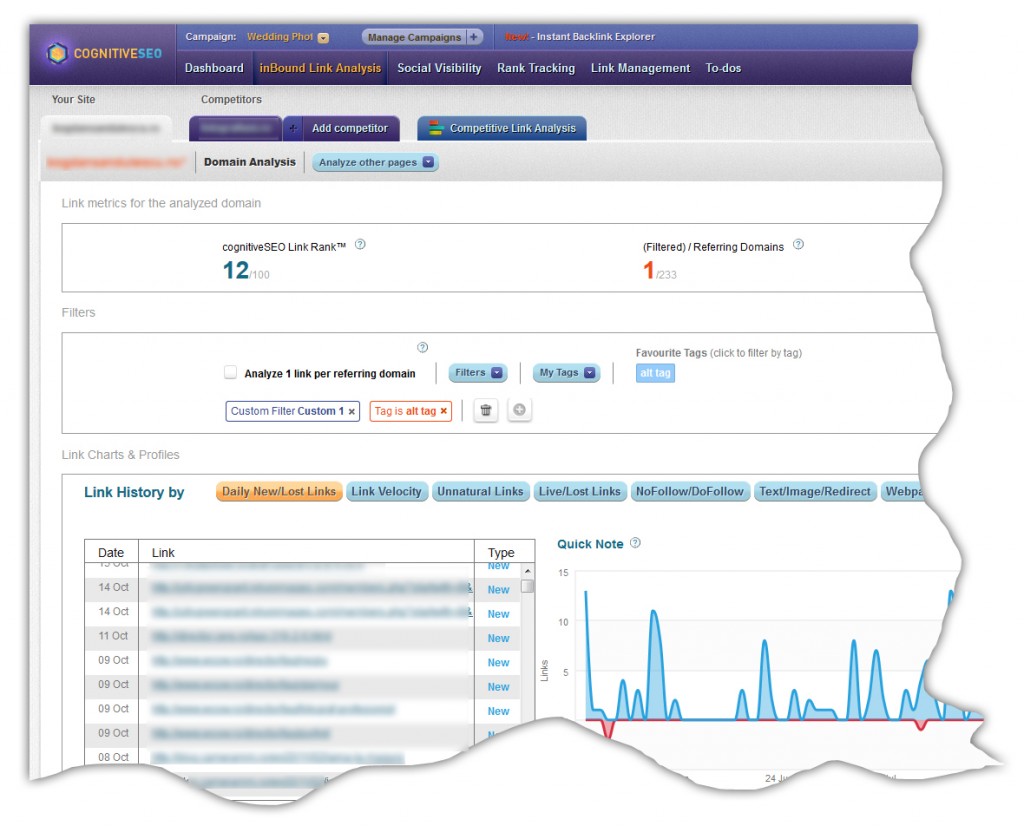 In the inBound Link Analysis module top left area you can see your website and your competitors’ websites lined up in a tabs display.
In the inBound Link Analysis module top left area you can see your website and your competitors’ websites lined up in a tabs display.
In order to add a competitor, click on the Add Competitor button.
A pop-up window will be displayed and you can add your competitor site. The new competitor site will inherit the same settings as the other competitor sites added at the beginning of the campaign. You can choose to analyze your competitor’s website at a domain, subdomain or prefix level. Also, by choosing to see the advanced options you have the option to analyze just specific sub-domains URLs. Just like in the case of your website, you can choose to run the analysis with imported links only. By selecting this option we will crawl only the links you imported and ignore any links we have in our database.
In the option bar placed just under the tabbed domains, you can analyse other links from your own website, by pressing the Analyze Other Pages button. You can select each link individually or select the “entire site” option which is also the default option.
You can select the main page or search by keyword if you’re just interested in analysing a certain directory for example. If you hit Save and close the dialog, the drop down will close and the screen will refresh automatically. The new data display will give you the inbound link analysis for the custom url selection you just made.
This button is active only after the campaigns that have at least three runs. In this way, after three weeks from the campaign creation, the Latest Links button will be functional and display data.
This is a dropdown button where you can select only the links analyzed in a certain time interval. The link history is only available from the moment the campaign was created, though the website might have existed before. All the data will be reloaded to illustrate only the link analysis over the selected time interval.
The import follows the same process as the initial creation of a campaign. The new links are crawled by our system and this process will probably take somewhere between a few minutes and an hour, depending on the file size. You can import as many links as your subscription allows you. The $99 package has a superior limit of 10000 links per site. The $199 package allows up to 15000 links per site and so on. This information is also available on the site’s Pricing page.
If you want to see an analysis for the newly imported links you can go to the Filters button -> Attributes ->and select Imported Links. The system will now display an analysis only of the imported links.
Dialog Options
| Import Format |
Select from the available links providers. To import links you can use one of the most used link providers, for examle Google Webmaster Tools. This Google tool will provide all the links that Google “sees” as related to your domain. It is recommended that you import in your campaign the Google Webmaster Tools file, which adds some extra links to your campaign. Although CognitiveSEO aggregates data from different providers, Google remains an important provider that shouldn’t be overlooked. And since the Google Webmaster Tools provider does not allow automatical integration, it must be imported manually. Other supported providers for newest links are Bing Webmaster Tools, following the same principles as Google Webmaster Tools, and also our very own CognitiveSEO Webmaster Tools. |
| CSV File |
From Google Webmaster Tools there are several formats that are available for download. Cognitive SEO supports the CSV version. You can download it and use it as it is or you can change it to the format you need.Therefore you should go to https://www.google.com/webmasters/tools/ and download the CSV file with the latest links: |
| Import CSV | After you’ve saved the CSV file, when you hit the Import button, the import action will be performed, according to the rules specified in the yellow highlighted area: “The CSV file will be automatically filtered with the same site-wide X settings used in your campaign and only links pointing to http://yourdomain will be imported”, where X can be up to 20 links form the same referring domain. X is set at the moment you create your campaign. This number is restricted because beyond 20 links per referring domain we run the risk of polluting our analysis with irrelevant data. In very few cases we have more than 20 links with real value from the same referring domain. What is over 20 links will usually come from blog-rolls, footer links or links that are automatically replicated several times on the referring domain. It is important not to try to import files larger than 25000 links, as the system will not support them. However, if you have a file that is larger than 25000 links, we recommend that you split this file in more smaller size files in Excel or some other tool that you are comfortable with, and import the resulting files afterwards. |
| Cancel | Press this button to cancel the import. |
| Import History | Here are listed all the details about your import: Date, Type, Links in CSV, Links Imported, Links with Errors. At the moment of import, if the link you want to add already exists in our system, the link will not be imported and will be displayed in the “links with errors” category. Practically, if you import 1000 links and 900 of them already exist in the system, those 900 will be displayed in the links with errors category. From the remaining 100, 70 of them may not be imported as they will also fall under the links with errors category. So in our example somewhere around 30 links of the initial list will actually be imported into the system. |
| Google Webmasters Tools Sample Import | From this link you can download a sample Google Webmaster Tools CSV file. This is a control import only, to help you visualize the steps of an import and the file type you should be getting from Google. |
Dialog Options
| Ignore Google Disavow File | This feature gives you the possibility to ignore an existing Google Disavow File that you’ve already successfully uploaded. This way, the analysis won’t take those links, subdomains and domains into consideration. At the newt recrawl, the files uploaded here will remain ignored. |
| Ignore Domains, Subdomains, Links | In this text box, please add the domain, subdomains and links that you want to exclude from the analysis. You can add and remove rows from this list anytime you want. |
| Submit | When you press the Submit button, in our database we apply an ignore flag to the corresponding links and domains. The links will also be subtracted from the table top link counts, and they will be displayed in the Ignored links area. |
| Cancel | Press this button to cancel the Ignore action. |
The Ignored links will actually act as a filter, causing the system to filter out of your analysis the ignore links and domains. That’s why it is only logical that you should find the Ignored Links in the Filters area.
 At mouse over, the Hide (…) Ignored Links option displays a text that lets you know you can choose to re-add the ignored links to the analysis by simply un-checking this box, or you can apply a View only the ignored links filter in Filters->Attributes->Ignore Links.
At mouse over, the Hide (…) Ignored Links option displays a text that lets you know you can choose to re-add the ignored links to the analysis by simply un-checking this box, or you can apply a View only the ignored links filter in Filters->Attributes->Ignore Links.
In the CognitiveSEO tool you can work in absolute or relative mode. This refers to how certain graphics are displayed. For example, in the Webpage Type graphics, in the Absolute mode, only integer numbers will be displayed. In Relative mode, the same graphic will display percentage numbers.
The Relative viewing mode is most useful in the Competitive Link Analysis area, where you can compare all websites analyzed in this campaign, side-by-side. This page will display all over again all graphic types that were also displayed in the individual link analysis. This allows an easier comparison between sites.
You can use the PDF button ![]() to generate PDF reports of your links analysis.
to generate PDF reports of your links analysis.
Link Metric Area
 Dialog Options
Dialog Options
In this window you can choose to ignore from your analysis particular links or entire domains.
| CognitiveSEO Link Rank |
At mouse over you can see a short explanation of this concept: “CognitiveSEO Link Rank is calculated based on a formula that takes into consideration multiple internal and external factors by applying a certain influence on each metric.” |
| Referring domains vs. Total Domains |
Referring domains means the number of domains analyzed in our system. Total domains means the total number of links reported by the link providers. Also, discrepancies may appear due to your chosen subscription that limits the number of domains we can analyze for your campaign. For example if a domain has 100000 links, if you have purchased the$99 package, we can only analyze the first 10000 links from that domain. It is very important to know though how those links are distributed, from the referring domain point of view. This means that in the first 10000 links we can find 100 referring domains or 1000 referring domains. There is no way we can know this distribution of the beginning of the campaign. The analysis of a site is considered complete when these two numbers become equal or the difference is very tiny. If they’re not equal and the number of referring domains is much less than total domains, we recommend upgrading your subscription to a superior package. This will allow you to analyze substantially more links in your campaign. |
| Links Analyzed vs. Total Links |
Analyzed link means all links analyzed in this report. Total links means all links provided by our data providers. At mouse over you can see more details about what these numbers actually mean. This reads: “You might notice a discrepancy between these two numbers. That is because we extract only the newest and most important links (up to 20 per referring domain). The rest of the links are site-wides that distort your analysis and do not present any value from an SEO point of view. A complete analysis is, as stated before when the Referring Domains number is almost equal to the Total Domains number, and is not related in a specific way to the difference between Analyzed links and Total links. |
Analyze 1 link per referring domain
With this option, you can analyze the most important link from each referring domain. This means that if you analyze 500 links coming from 100 referring domains, checking this option will allow you to restrict your analysis to those 100 referring domains. The most important link is selected using our aggregated Rating metric.
When you click this option, you will see that the Links Analyzed number will be equal to the Referring Domains number.
In the Filters drop down you have many filters grouped in four main categories:
- Attributes -> These are attributes of the link: Link Naturalness, Link From, Link To, Link Status, inBound Link Title, Link Anchor Text, Link Anchor Title, Text/Image/Redirect Link, Link Anchor Target, NoFollow Link, Imported Links, Ignore Links, Disavow Links.
- Features ->These are features of the link: Brand Anchor Text, Link Positioning, Link Visibility, Link Context, Sitewide Link, Deep Backlink, Deep Link, Webpage Type, Webpage Category, Webpage Language, HTTP Status Code, Domain Name, Domain TLD, Website Hosting IP, Website Hosting IP Country.
- Metrics -> Various metrics on link level and domain level: Link Influence, Domain Influence, Google PageRank (main page), Webpage ACRank, Link Trust Flow, Domain Trust Flow, Link Citation Flow, Domain Citation Flow, Inbound Links, Outbound Links.
-
Custom filter -> combination s of 2 or more native filters.
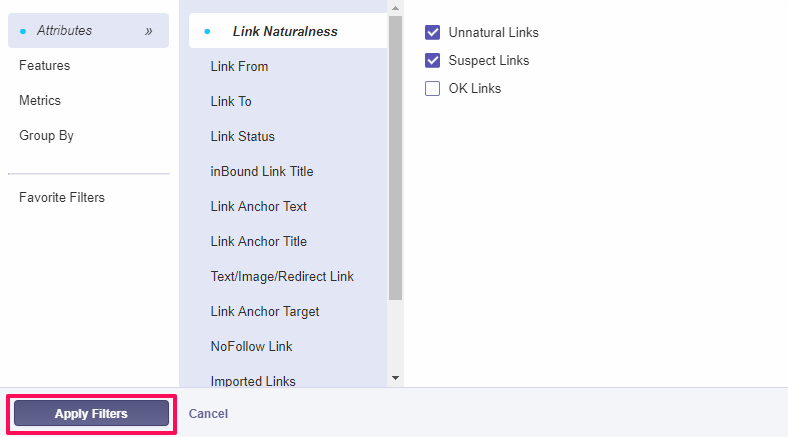 When you apply a filter, the data on the entire page is recalculated. For example, from Filters -> Attributes you can select Link Status, a filter that gives you the possibility to view an analysis either of live links or of lost (broken) links. If you select Link Status Is: Live, the analysis is based only on live links, that means the broken ones are not taken into consideration.
When you apply a filter, the data on the entire page is recalculated. For example, from Filters -> Attributes you can select Link Status, a filter that gives you the possibility to view an analysis either of live links or of lost (broken) links. If you select Link Status Is: Live, the analysis is based only on live links, that means the broken ones are not taken into consideration.
Filters are important because you can choose to analyze only a certain aspect of your campaign, or a specific combination of factors.
Each time you apply a new filter, the number of analyzed links decreases, as some link categories are filtered out of the analysis.
The applied filters will be listed in red on your screen. You can remove them one by one by pressing the X marks. As soon as you have at least two filters applied, another option becomes available:
| Save as favorite filter | Save as Custom Filter button, that you can use to define a custom filter using the already selected filters. If you go and select another filter (for ex. Do Follow) without de-activating the previously selected filter, the analysis will be made based on a combination of these two. We now have what we call a combo filter that can also be saved as a custom filter, so you can apply it any time you need. |
As a third filter, let us apply one from Metrics category -> Domain Influence -> High. So we are only interested to analyze links that come from a high authority domain. This is, for example, a good way to find out the most important links of your competitors.
There are endless filter combinations in Cognitive SEO and you can use them as creatively as you can think of, according to your needs at a certain time.
If you select a custom filter, at mouse over, a list with all filters creating the custom filter will be displayed. Using custom filters is important to save time because once you save it you can apply it to any of your campaigns, at any time. The recalculation of data takes time and this time can be saved with custom filters.
In the filters area, you cannot save custom filters that include another custom filter. All custom filters must be a combination of native filters
In Data Table (last table on the page) you can see all the links that made it to your analysis after applying the filters. You can export this table using the Export option. All the graphics and charts above only refer to the links in the Data Table.
You can apply tags in the last table of the analysis, by placing the mouse over any chosen link and clicking the Apply Tag option.
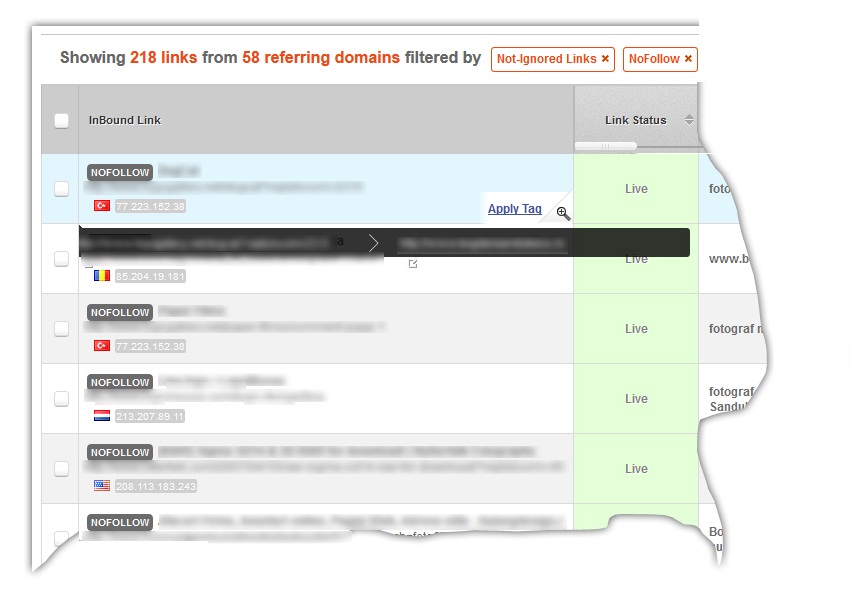 Fill in the tag name and press Save or Cancel. If you choose to save the tag, it will appear in the tag list, and by selecting it, the system will recalculate your analysis based only on the links that have this tag .
Fill in the tag name and press Save or Cancel. If you choose to save the tag, it will appear in the tag list, and by selecting it, the system will recalculate your analysis based only on the links that have this tag .
You can also apply what we refer to as a Bulk Tag. A bulk tag is applied by selecting the desired links in the last table and applying the tag. Or you can select the desired links, then choose Bulk Actions -> Apply bulk tag.
If you want to delete a tag, you can also perform the operation individually on each link or select them in bulk and choosing the delete tag option either from the table or from the Bulk actions list.
In the tags list you can mark tag as a favorite, and it will be listed in the Favorite Tags list. When you click a tag, the entire page will be filtered by that tag. Another important feature is that you can apply tags and filters combined. For example, you want to see only the links that have Tag#1 and Status->Live. These combinations can also be saved as custom filters.
You can change tag color and name, or you can unmark tag from the X button. A tag is saved into the system even if you log out. But when you don’t need it anymore, you can delete it from the Delete button. It is important to know that once you do that, only the tag is deleted and not the corresponding link(s).
Link Charts and Profiles
Link History By
In this area, on onetime snapshot campaigns, only the Link Velocity chart is available.
The Link History By metric gives you the number of new links/month since the beginning of the site. The timeline at the right shows new links and lost links for the analyzed link (domain) on a daily basis, since the beginning of the campaign. Every 2-3 days the system is updated. The new data is viewable in the table and on the timeline.
Common Dialog Options
Includes two charts:
- Link velocity since the beginning of the site
-
New links and referring domains that appear on a monthly basis.
This chart is non-cumulative.
In Analyzed Links the chart is the cumulative total number of analyzed links per referring domain existing into the system. This graphic starts at the campaign creation time, and there is no history for it.
This is a very important chart in your analysis. Here you can see the natural and unnatural links evolution into the system, and with the help of this graphic, you can protect your domain from negative SEO, or you can manage the risk of being penalized by Google due to unnatural links that you have. All graphics in the Cognitive SEO system, except for Daily New Lost Links and Link Velocity are updated weekly, at campaign reruns.
One graphic represents the number of live links, and the other one the number of lost links and how they’ve been evolving since you started the campaign.
One graphic represents the number of NoFollow links, and the other one the number of DoFollow links and how they’ve been evolving since you started the campaign.
Three graphics presented here: One for text links evolution, one for image links, and one for redirect links.
This is another very important graphic. It gives you the strategy that is used in the link acquisition campaign of the analyzed site.
You can analyze your own strategy or those of your competitors. For example you can see that the majority of links come from web directories and that this trend is ascending. At the same time, there is a decreasing trend on link acquisition on blogs and an ascending trend on forums.
These charts are created based on our own algorithms and cannot be found anywhere else.
This chart illustrates the historical evolution of 5 link categories, according to their position on the linking page:
- Link in group of links (blue line)
- Link in blog comment (cyan)
- Link in text paragraph (red)
- Image link (orange)
- Banner link (yellow)
In this graphic you can see the evolution of links content-wise. It helps you figure out what type of content do your links come from.
There are 19 categories we classify links by with English and Romanian languages supported: Art, Auto, Business, Careers, Culture, Education, Fashion, Food, Games, Garden, Health, Hobbies, Home, Pets, Recreation, Relations, Sports, Technology, Travel, Gambling, Other.
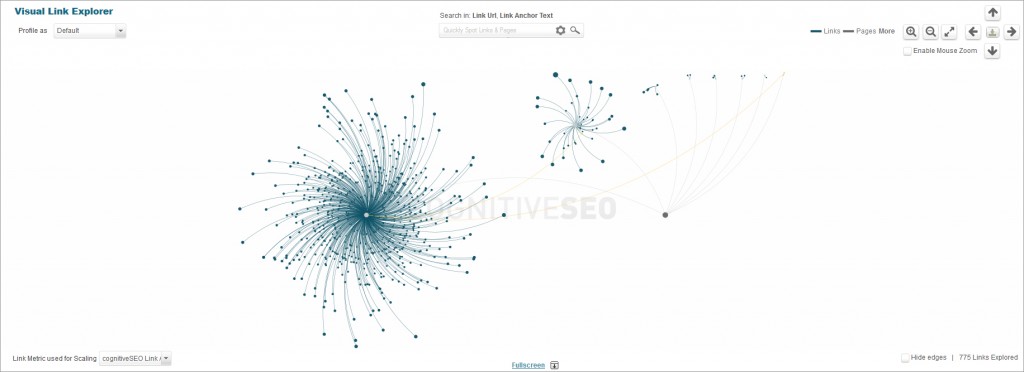 This is a unique feature in an SEO tool. It offers you beautifully presented and easily understandable information at the same time.
This is a unique feature in an SEO tool. It offers you beautifully presented and easily understandable information at the same time.
Principles of Use
Here are the principles to understand in using this feature:
| Clusters | The clusters presented in the graphic are the pages on your website. |
| Points (Nodes) |
The blue and yellow points are links that point to different pages. When you click on a link node, a box with more info is displayed. You can even switch the viewing mode or add tags for the respective node. |
| Enable Mouse Zoom | If you choose this option, you can now zoom-in and zoom-out on a chosen cluster, as well as navigate on any direction on the picture. At mouse over on the central point you can see for which link the link cluster is displayed. |
| Distance from the cluster center | As a points distance from the cluster center grows, the link quality is better. The quality is given by the scalability metric. The closer the links are to the center of the cluster, their quality decreases. |
| Link Metric Used for Scaling | By default, the metric used is Link Influence. But you can change this metric and choose another one to measure link quality, for example domain influence. The clusters will be recreated and you can now find out which is the most important domain that refers to your link. |
| Profile As |
There are more profiles available that can be applied to this graphic. You can remain on the default profile or you can change it. If you select Unnatural links you can see how unnatural links point to certain pages. For example you can see that most of the unnatural links point to the main page. If you use the Live/Lost criterion, you can identify where in the site there are problems with broken links. |
| Color Legend |
|
| Search box | This analysis can be used to search. Place the cursor in the search box and insert a keyword. For example, if you type in “blog”, the graphic will highlight all links that contain in the URL and anchor text the word “blog”. You can also restrict your search to anchor text only. |
| Hide Edges | The edges (lines connecting the nodes to the cluster ceter) can be hidden if you don’t need them anymore. |
| View More | Only up to 2,500 links are loaded into the default view. If the site has more than 2,500 you can press the View More button to view up to 5,000 links. |
| View All | If there are for example 10,000 links in all, you can either increment the analyzed links by 2,500 or load the entire links profile at once by pressing View All. You will be notified that the system might be overloaded. |
| Full Screen | In order to have a better view of this chart, to present it in a conference and so on, you can display it in full screen mode. |
How This Graphic Is Useful
We, and many of our clients have some favorite modes to use this feature:
- A tool to see on the spot your keywords coverage.
- For research
- For pitching – because this tool presents a sort of an overview of the site and its in-bound links, it is easier understandable by someone who does not necessarily know SEO, but to whom you need to present the power of CognitiveSEO as a campaign optimization tool and the value of the service you can provide. Being an interactive tool and not just a drawing, you have the possibility to throw in quick explanations about their profile or their competitors profile, which makes the presentation more to the core.
-
For reporting
Unnatural Links Detection
Overview
First of all, we shall review the situations where you need to use the unnatural links detection widget.
If your site has been penalized by Google, or if you think you’re suffering from a negative SEO attack, or if you want to manage the risk of being penalized in the future, then this widget will ease your job.
Regarding the technology that is being used behind the unnatural links detection widget, we have a very large set of rules that we apply to each and every link that we crawl.
First of all, it’s important to know that the unnatural link detection is only performed on live links, because we do not consider lost links of any value for your website, as they can be no longer disavowed or removed. So when we go and realize the classification of links we apply a very complex algorithm to each and every relationship that we find in your link profile, and based also on the classification that you did in the “brand vs. commercial” anchor text, we use that information, plus many, other signals.
We have over 50 rules in our system that are specially designed in order to detect both unnatural links and OK links. We have false positives and negatives of course, but we chose not to give you the direct score, because that might be confusing. In this way, when we created this widget we made the choice of splitting the links in 3 very simple categories and those are the unnatural links, the suspect links and the OK links. We think these categories are pretty much self-explanatory. By using our complex algorithms and artificial intelligence behind it, this widget can tell you where the links in your link profile fit.
It’s also important to know that if we are wrong in our classification, because this is automatically done by a software with no human intervention at all, you have the possibility to reclassify that link. You can easily reclassify a link that has been marked as unnatural when in fact it is an OK link, and your final classification will be saved into the system.
Any software has a false-positive ratio. We proud ourselves with a very low false-positive ratio, and with our latest upgrade we’ve added even more rules, and fine-tuned the existent ones, based on the feedback that we got from our customers and based on the saved datasets that automatically reclassify any link in the system, basically a self learning process.
Link Distribution Chart
First of all you need to see how affected is your site by unnatural links. For a quick indication, you can see the links distribution chart right at the top of the widget:
Above the graph there is also a text hint, which in this case reads:
This site has a highly unnatural link profile and it’s likely to be already penalized by Google. You should use the Link Navigator in order to mark the unnatural links for Disavow or Removal.
Other scenarios are:
This site has a suspect link profile and should be investigated carefully. There is a high chance that this site might be penalized in the future for unnatural links (if it wasn’t already).
This site has a good looking link profile. Continue to monitor it, in order to avoid any unnatural link penalties from Google.
Every area in the graph is clickable. If you click on any of the categories, you will be filtering the links profile table by the selected category. For example, if you only want to see the Unnatural and Suspect Links, you have to uncheck the checkbox on the OK Links segment.
Dialog Options
Once you click on a click, the Link Navigator will open and you can find information on a specific link. In the bottom right of the window, there is the Link info button. It explains the reasons why the link was classified as suspect or unnatural.
Going through all the links profile table can be a bit slow, and that’s why we created the Unnatural links navigator that you can find in the top-right corner of the Unnatural Links Detection widget.
By clicking on this button you will open a totally new interface that will allow you to very quickly move through all the links:
This cutting edge tool will allow you to quickly browse entire link profiles of sites.
At the left we have the actual page and we have highlighted the link to your page. In this way you can browse very fast through all the links, while in the background the system also performs a pre-cache of all the pages you see loaded here.
All the actions you perform in the navigator are saved, so if you close it and open it later all your previous actions will be there.
Once you start browsing the links list, you can see the content of the pages where the link is placed and the reason why the link was considered to be unnatural or suspect. By hitting the D key on your keyboard you will mark this link/domain for disavow. The process is very fast because it just requires two clicks to analyze and apply an action for each link.
When you’re done applying actions to all unnatural and suspect links (ignore, disavow, tag and/or reclassify) you can go back to the previous screen and export the Google Disavow File from there.
Dialog Options
| Domain/Link | You can decide whether you want further actions to be applied at link or domain level |
| Disavow | Mark link for disavow. |
| Ignore | Ignore individual link. |
| Tag Link | Apply a tag to this individual link. |
| Reclassify | Reclassify this link. |
However, the Unnatural Links Navigator should not be used exclusively for unnatural links. It can be used to quickly browse and review all types of links, including the OK ones.
Navigator Options
Table Options
Top Linked Pages refers to the pages from the analyzed site, and recurring domains and links pointing to each of them.
If you click the Expand button, you can see the first 50 pages. As with Visual Link Explorer, in order to avoid page load, the system only loads the first 50 pages, but you have the possibility to add increments of 50 pages by using the View More button, or you can use View All to load all pages. The pages are ordered descending, by number of links.
If you click on a green stripe, a pop-up window opens listing referring domains for that page. If you click on the blue stripe, a pop-up displays referring links for the page.
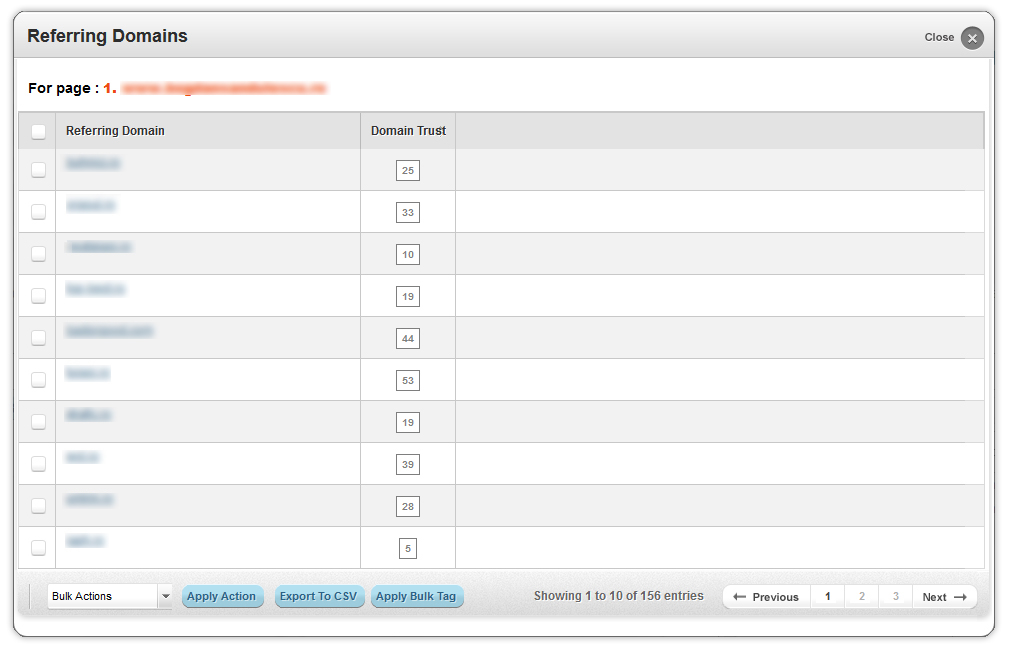 From these pop-up you have several possible actions: Apply Action (Ignore, Un-Ignore, Disavow, Un-Disavow, Reclassify), Apply Tag, Export to CSV.
From these pop-up you have several possible actions: Apply Action (Ignore, Un-Ignore, Disavow, Un-Disavow, Reclassify), Apply Tag, Export to CSV.
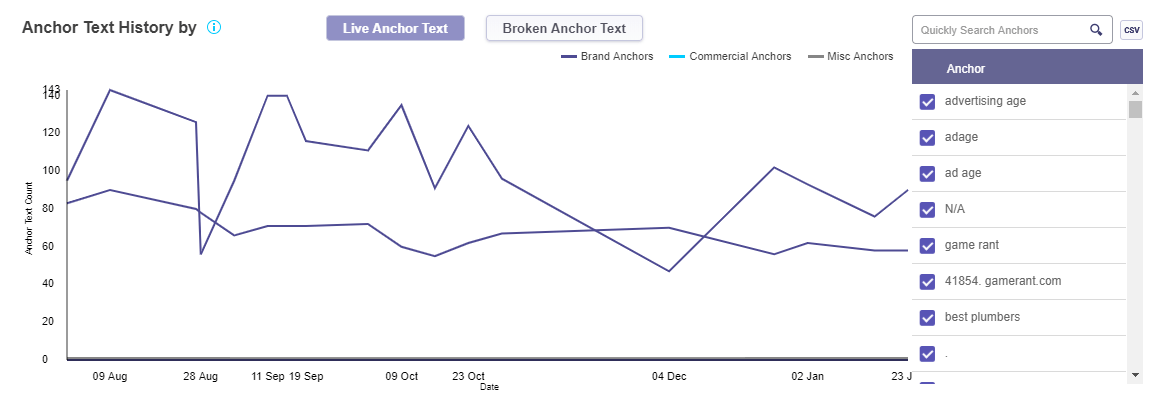 This graphic refers to the evolution of a certain anchor text at every weekly regularization.
This graphic refers to the evolution of a certain anchor text at every weekly regularization.
Options
| Live Anchor Text/Broken Anchor Text | In this graphic you can toggle between Live Anchor Text view and Broken Anchor Text view. Live Anchor Text view is selected by default. |
| Brand Anchors | Click this option to highlight brand anchor text in blue. |
| Commercial Anchors | Click this option to highlight commercial anchor text in red. |
| Misc. Anchors | Click this option to highlight miscellaneous anchor text in gray. |
| Highlight Curves | At mouse over in the Anchor Text History Table, the referred link is also highlighted in the graphic. |
| Search Anchor Text Table | You can choose to see anchor text history for only certain keywords. In this case, you can use the search box. |
| Select Anchor Text | You can select more anchor text links in the table and they will remained marked in the table and also be highlighted in the graphic. |
| Export to CSV | All anchor text history data can be exported as CSV. |
Anchor Text Distribution and Classifier
By default, at the campaign run, the commercial area is not colored. The name of the site is added automatically in the Brand keywords category. You have to classify the keywords by yourself in one of the categories: brand, commercial or miscellaneous. The Brand Keywords will be listed with the blue color, the Commercial Keywords will be listed in the red color while the Miscellaneous Anchor Text (any keywords that doesn’t match the brand or commercial category) will be listed in a grey color.
Brand vs. Commercial
A common challenge for all our clients is how to define brand keywords vs. commercial keywords.
|
Brand Keywords |
The domain name is automatically added here by the system. For a better understanding, let’s take as an example COGNITIVESEO.com. Besides “COGNITIVESEO” and “COGNITIVE SEO”, you might also add “COGNITIVE” as a brand keyword. While “COGNITIVE SEO” is like an unique identifier for your brand, the word, “SEO” defines your activity in a general manner, it places it in a category, but “COGNITIVE” is your brand’s unique attribute in the SEO category. In other cases, we might run the risk to use a word that is part of another brand. Let’s take a hypothetical example. If there is another brand called “COGNITIVE LINKS” and it links to our site, the word “COGNITIVE” cannot be included in our brand keywords anymore. |
| Commercial Keywords | In the Commercial keywords text area should be all keywords that represent your business, non-brand. If our site is COGNITIVESEO.com, the combinations of commercial keywords is infinite (and this is the case with every domain): SEO, LINK MANAGEMENT, RANK TRACKING, INBOUND-LINKS are just some examples. |
| Miscellaneous Keywords | If there are keywords left in the miscellaneous category (gray color) that you think belong in the commercial category, you can add them also. You can come back and complete or modify the list at any time. Usually, in the gray area must remain only informational keywords, such as “click here”, “website” etc. |
| Note |
Ideally, the percentage of brand keywords used in links should be much higher than the percentage of commercial keywords used in links. |
Classifying the Anchor Text
Understanding how to effectively classify the brand and commercial anchor text is crucial in order to have an excellent unnatural link detection classification.
1. Bulk Classify Anchors
This feature allows you to to quickly classify multiple anchor text keywords in bulk. In order to do that, you first need to search for the relevant keyword and, then choose what type of classification you want (brand, commercial or misc) and hit the apply button. All those anchors will be classified in bulk instantly.
2.Individual Anchors Classification
You can choose to classify each keyword individually. All you have to do is hover over the wanted keyword (pass your pointer over the wanted keyword) and a menu with “classify as: brand, commercial or misc” will appear. Thick the classification you wish for and your job with that anchor is done.
3. Classify Quicker by Showing Only Unclassified Anchors
Show Only Misc Anchors helps you to finish your classification process quicker by showing only the Unclassified or Misc Anchors. By checking this option you can see what keywords are neither in the brand or commercial category and might need to be further classified. When Show Only Misc Anchors is on, all your actions will be applied only on the miscellaneous keywords.
Options
a. Filter The Anchor Text
To make your job easier, we’ve created the Quickly Search Anchors search box. You can type here a specific keyword and the widget will only show you the anchor texts containing that keyword.
b. Show only Live Links
By default, the anchor texts for your entire link profile will be listed. But if you want to see the anchor text for live links only, you now have the show only live links option.
c. Disable Classifier
If you don’t want to work with the Anchor Text Classifier or you’ve finished classifying all the anchor texts and you don’t want to make further changes, you can choose the Disable Classifier option. You can hit this button at any moment of your analysis. The process is reversible (meaning you can go back to classifying anchor texts any time you want).
d.Ordering Options
We’ve created some ordering options that will be useful if you want to take some snapshots to include in a presentation or to visualize the keywords that really interest you. For example you can randomize your anchor texts in order to make an image about your overall anchor text profile, or you can have your keywords ordered by their strength or by brand.
e. Display Keyword Information as a Table
Once you’ve hit this button, the anchor text will be listed in a table where you have the possibility to see the number of links and domains for each anchor text.
f. Export to CSV format
When you press this button, the download of a report in CSV format will be done instantly.
Exact Match Domain (EMD)
This is an exceptional case. For example, if you have a domain called ONLINECASINO.com, in the brand keywords list you will write ONLINECASINO.com or simply ONLINECASINO, and in the commercial keywords list you will write ONLINE and CASINO on separate lines. This is because each word in the domain name is actually a commercial keyword.
Anchor text distribution is recalculated at each campaign rerun (once a week automatically by the system).
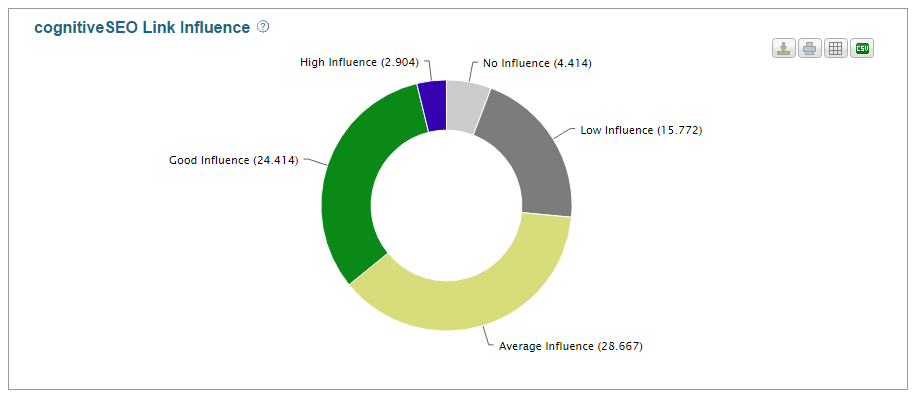
This is a crowd sourced metric giving you an overall information about the Authority of a linking page. It is calculated using multiple other metrics and gives a result that matches one of the 4 types of Influence (High/Good/Low/No). It is natural to have a high distribution of Low and No authority linking pages , because the web is formed of a very high distribution of low quality pages.
This metric does not reflect the naturalness of a link.
This metric aggregates data from various data providers. Based on our formula and on those metrics we obtain the CognitiveSEO Link Authority score. At click on the ring slices the corresponding links in the selected category will open.
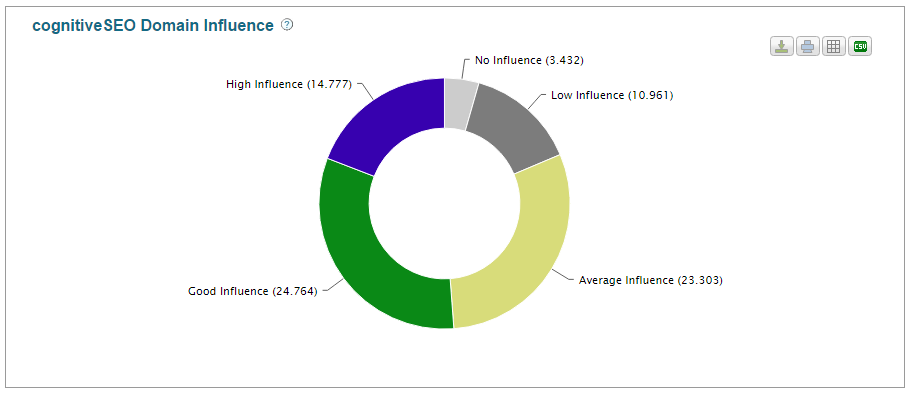
A metric similar with CognitiveSEO Link Authority is used to analyze the Authority of a linking domain.
This is a crowd sourced metric giving you an overall information about the Authority of a linking domain. It is calculated using multiple other metrics and gives a result that matches one of the 4 types of Influence (High/Good/Low/No). It is natural to have a high distribution of Low and No authority linking domains, because the web is formed of a very high distribution of low quality domains.
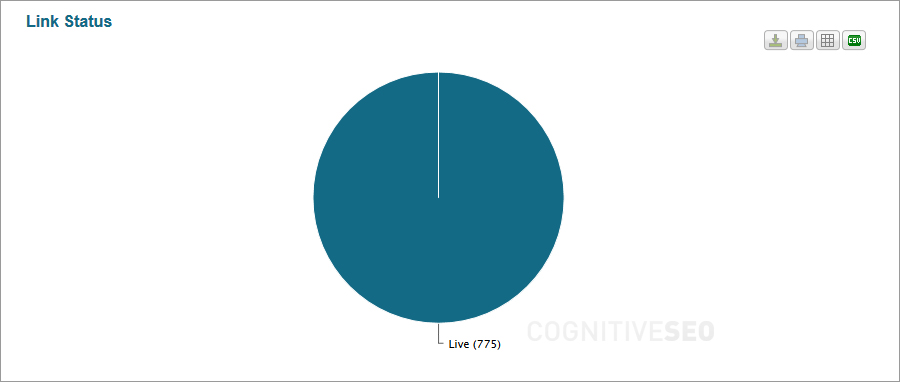 This is a pie chart that displays the live links versus lost (broken) links.
This is a pie chart that displays the live links versus lost (broken) links.
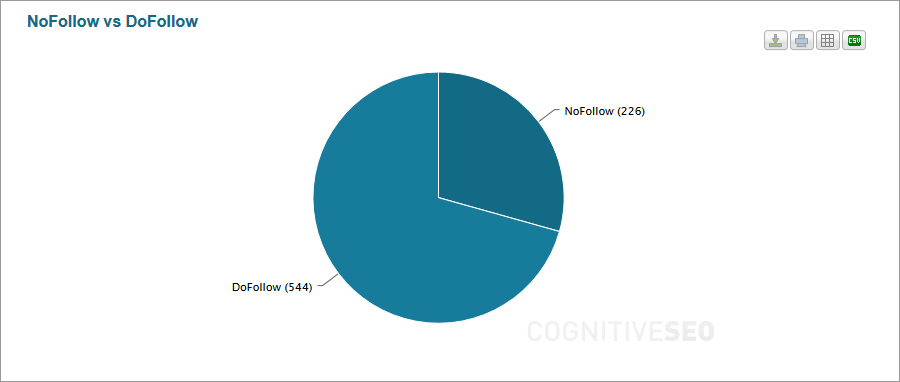 This is a pie chart displaying the no follow vs. the do follow links.
This is a pie chart displaying the no follow vs. the do follow links.
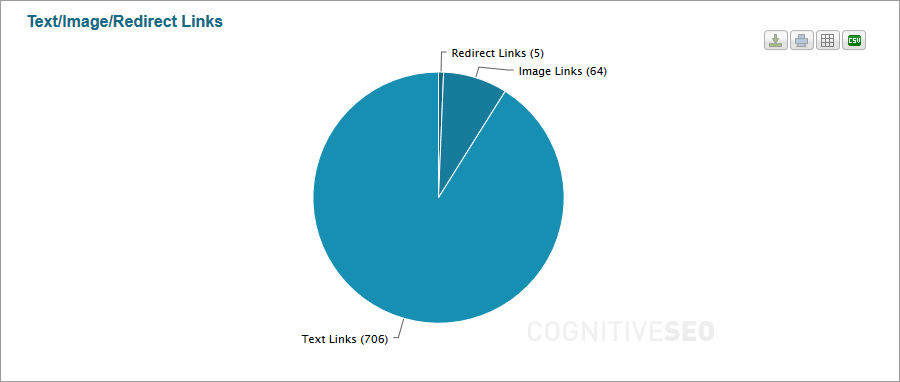 This pie chart displays the number of text links (normal, anchor text links), image links, and redirect links to your site from the total number of links.
This pie chart displays the number of text links (normal, anchor text links), image links, and redirect links to your site from the total number of links.
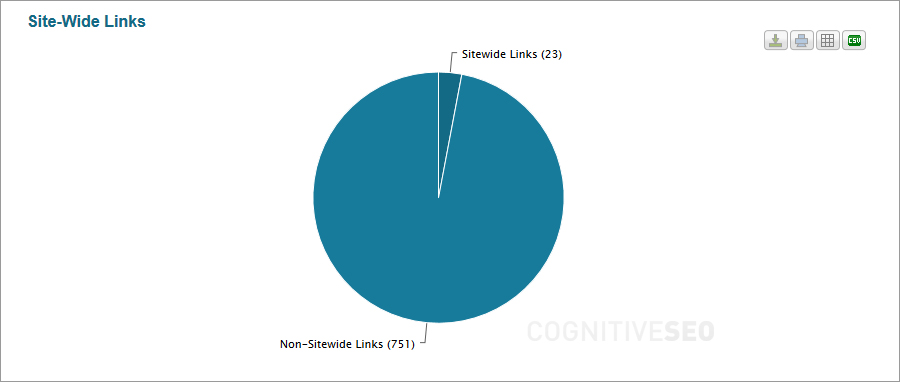 Site wide links are replicated on several (or all) pages of your site. For example the footer or blog-roll links are site-wide links. Not all of them have value for your analysis, so you can filter them out.
Site wide links are replicated on several (or all) pages of your site. For example the footer or blog-roll links are site-wide links. Not all of them have value for your analysis, so you can filter them out.
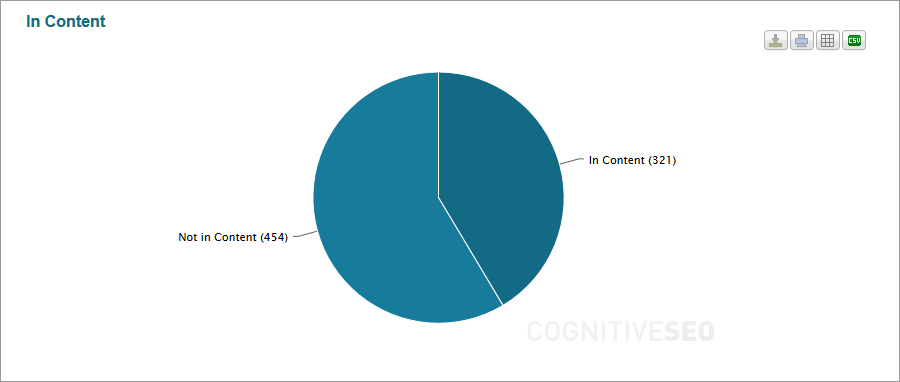 In this pie chart you can see the ratio of links that appear in content, versus the links that are separated from the content of a page (for example a link that appears in a group of links).
In this pie chart you can see the ratio of links that appear in content, versus the links that are separated from the content of a page (for example a link that appears in a group of links).
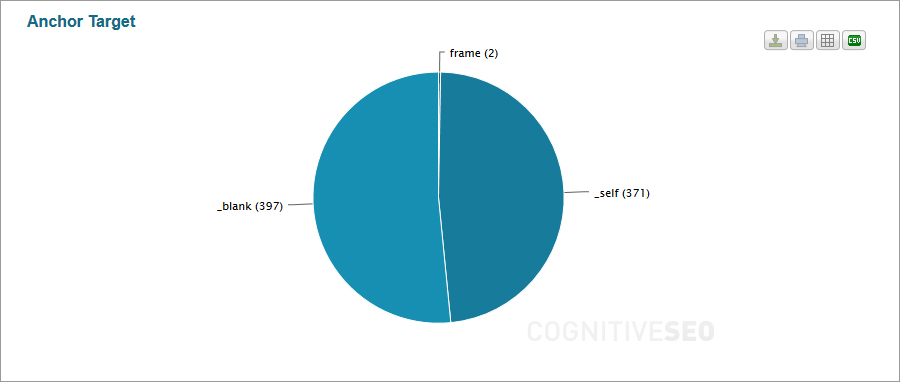 This chart classifies the links by their anchor target.
This chart classifies the links by their anchor target.
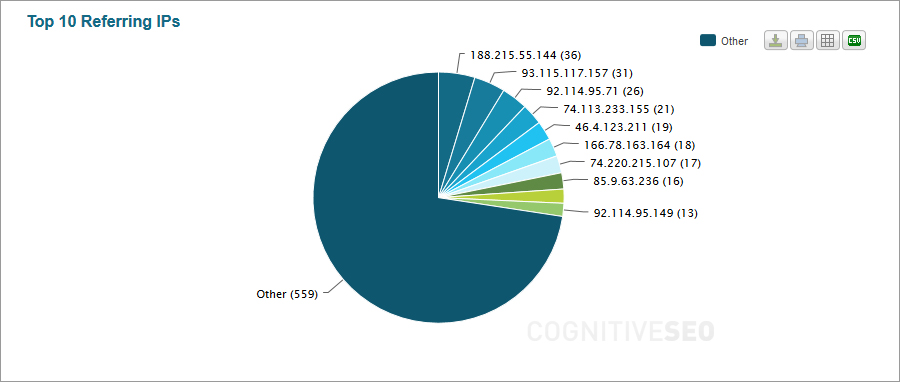 This pie-chart analyzes IPs that send you the most links.
This pie-chart analyzes IPs that send you the most links.
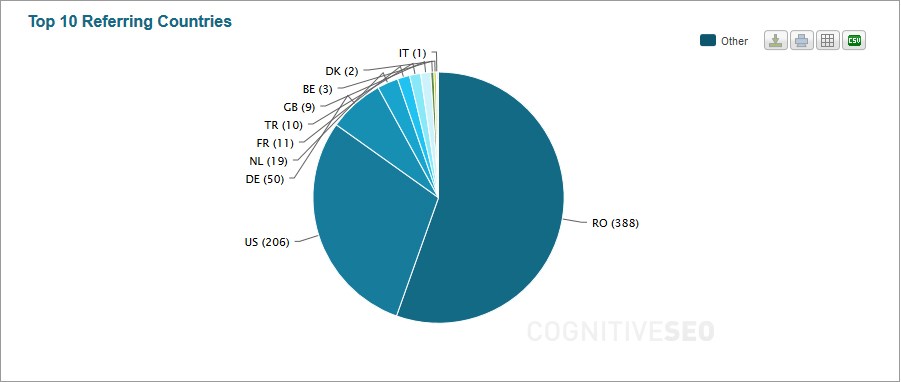 This pie chart analyzes from which countries come the IPs that send us the most links.
This pie chart analyzes from which countries come the IPs that send us the most links.
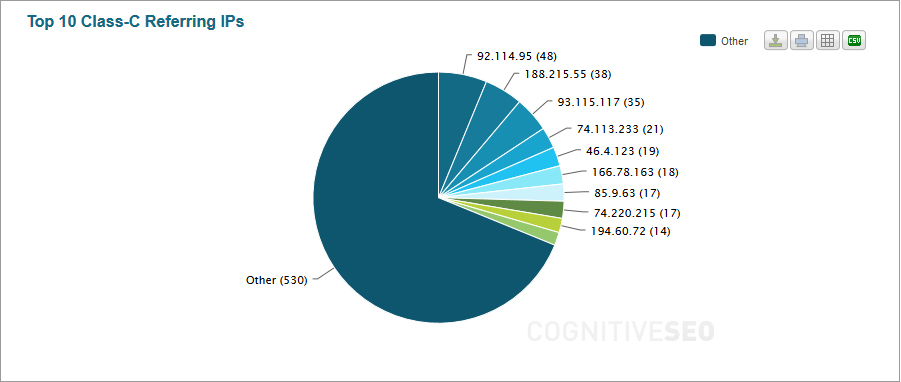 Class C refers to the third set of numbers in an IP.
Class C refers to the third set of numbers in an IP.
AAA.BBB.CCC.DDD
It is more likely that the links that come from the C subnet are less trusted than the ones that come from the A subnet and B subnet.
Deep Link Ratio
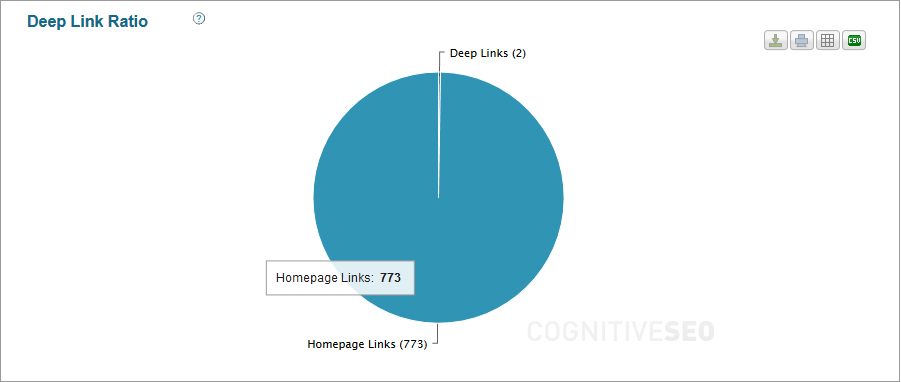 Deep link ratio is the percent of backlinks (or inbound links) that point at pages other than your own homepage. Examples:
Deep link ratio is the percent of backlinks (or inbound links) that point at pages other than your own homepage. Examples:
a.com -> b.com/test.html is considered a deep link.
a.com/long/link.htm -> b.com/online/line.html is considered a deep link.
a.com/long/link.htm -> b.com/index.html is considered a Homepage link
Deep Backlink Ratio
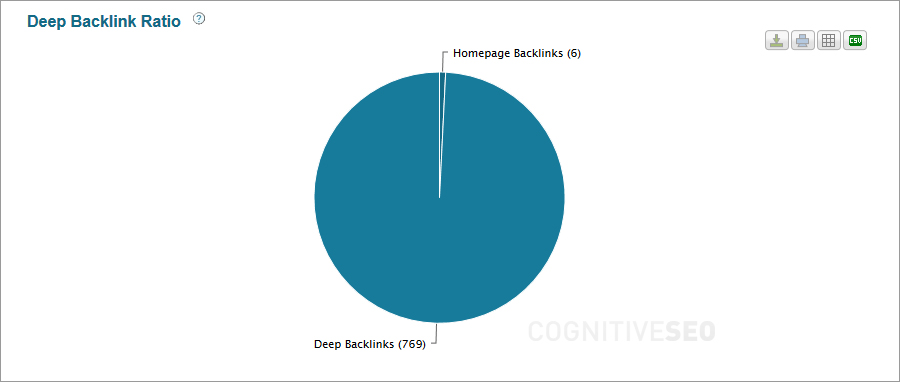 Deep backlink ratio is the percentage of backlinks or inbound links coming from deep pages vs. backlinks coming from root pages. Examples:
Deep backlink ratio is the percentage of backlinks or inbound links coming from deep pages vs. backlinks coming from root pages. Examples:
a.com -> b.com/test.html is considered a homepage backlink.
a.com/long/link.htm -> b.com/online/line.html is considered a deep backlink.
a.com/long/link.htm -> b.com/index.html is considered a deep backlink.
 From this chart you can figure out what is the main strategy a site uses to get links: web directories, blogs, forums, articles etc.
From this chart you can figure out what is the main strategy a site uses to get links: web directories, blogs, forums, articles etc.
 This metric shows with more accuracy where the link is placed on the page.
This metric shows with more accuracy where the link is placed on the page.
 There are three categories of where the links come from, from a webpage area point of view : Body, footer, header, with footer links being the least visible.
There are three categories of where the links come from, from a webpage area point of view : Body, footer, header, with footer links being the least visible.
 The website contents are classified in 19 categories and in this graphic you can see how links are distributed based on these categories. This is a metric that may also help you identify unnatural links, based on those categories.
The website contents are classified in 19 categories and in this graphic you can see how links are distributed based on these categories. This is a metric that may also help you identify unnatural links, based on those categories.
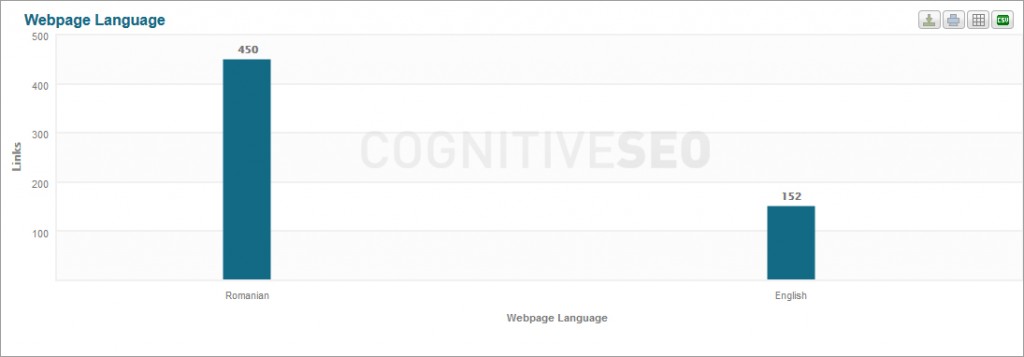 This chart displays how links are distributed based on the language of the pages that the links come from. In this case, you may identify unnatural links by the language of the page they come from. If it’s a language that is less likely to be spoken by those who visit your site, then maybe you should rethink your strategy.
This chart displays how links are distributed based on the language of the pages that the links come from. In this case, you may identify unnatural links by the language of the page they come from. If it’s a language that is less likely to be spoken by those who visit your site, then maybe you should rethink your strategy.
 This graphic displays how links are distributed based on their TLD names.
This graphic displays how links are distributed based on their TLD names.
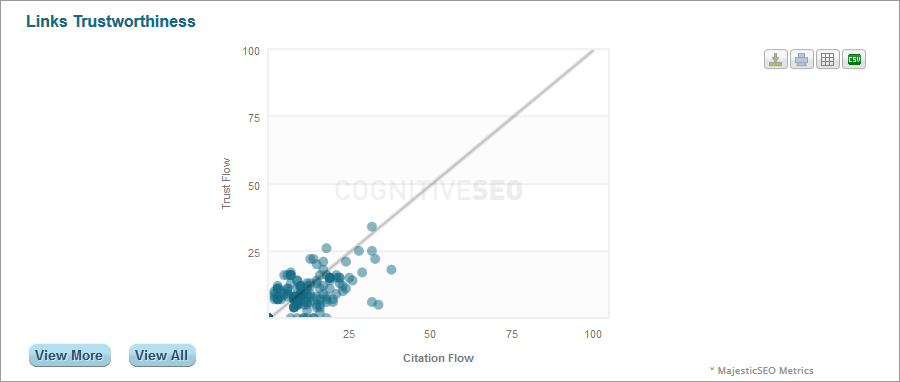 These data are provided by Majestic SEO. Majestic SEO is one of our providers and this metric is interpreted in the following way: The higher the point on the chart curve, the better the link quality, where the vertical axis represents Trust Flow and the horizontal axis represents Citation Flow.
These data are provided by Majestic SEO. Majestic SEO is one of our providers and this metric is interpreted in the following way: The higher the point on the chart curve, the better the link quality, where the vertical axis represents Trust Flow and the horizontal axis represents Citation Flow.
At mouse over on each point you can see the link name, as well as link’s Trust and Citation values.
Domain Trustworthiness
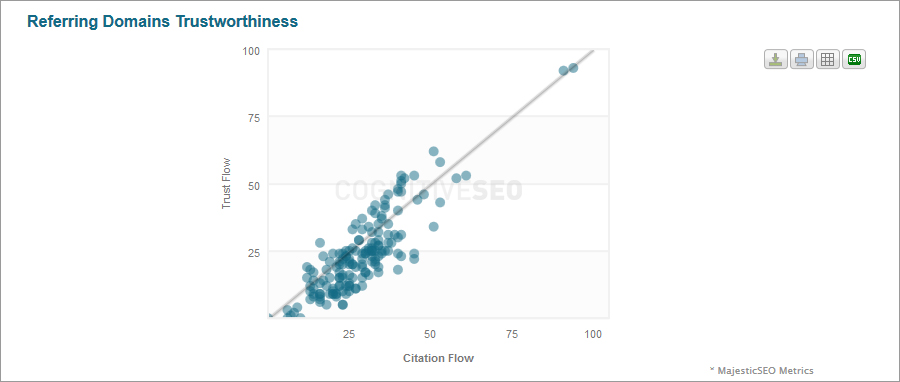 The data on this chart are interpreted similarly with those at Link Trustworthiness.
The data on this chart are interpreted similarly with those at Link Trustworthiness.
 Google PR is extracted for the home page and we can see a distribution of pr values of links pointing to our site.
Google PR is extracted for the home page and we can see a distribution of pr values of links pointing to our site.
Webpage ACRank
 This is a metric from Majectic SEO similar with Google PR.
This is a metric from Majectic SEO similar with Google PR.
 This graphic shows the links that point to the pages where we found backlinks. The larger the interval, the better for the link performance. If you click on a link that comes from a large interval category, you will see that the link comes from a page that has a high number of links pointing to it. That means having a link on that page pointing to your site is of greater value to you than having a link on a page with no links pointing to that page.
This graphic shows the links that point to the pages where we found backlinks. The larger the interval, the better for the link performance. If you click on a link that comes from a large interval category, you will see that the link comes from a page that has a high number of links pointing to it. That means having a link on that page pointing to your site is of greater value to you than having a link on a page with no links pointing to that page.
 With this metric, the exact opposite is true: the more links we have on a smaller interval, the better., because it represents links that point out of our site.
With this metric, the exact opposite is true: the more links we have on a smaller interval, the better., because it represents links that point out of our site.
 In the Data Table the system displays all links that comply with the applied filter or the user selected criteria.
In the Data Table the system displays all links that comply with the applied filter or the user selected criteria.
Data Table Options
This is the area where you can compare competitors.
This tab becomes available when there are at least two competitors in our analysis. The maximum number of competitors is 5, except for your own site. At the same time you can analyze data about a maximum number of 6 sites.
This analysis basically contains mostly all the graphics from the Individual inBound Link Analysis.
Competitive Link Analysis Options
| Latest Links | You have the possibility to display data only about the new links found at the last re-crawl. |
| Display Modes | You can display your data in Absolute or Relative mode. In this case the relative mode may make more sense for site comparison. |
| Produces a report with the current data on the screen. If you apply let’s say a new filter, the new PDF report will be showing the re-filtered data. | |
| Filters | Work in the same way as in Individual inBound Link Analysis. |
| Tags | Work in the same way as in Individual inBound Link Analysis. |
| Analyze One Link per Referring Domain | Has the same meaning as in the individual link analysis. |
| Cognitive SEO Link Rank |
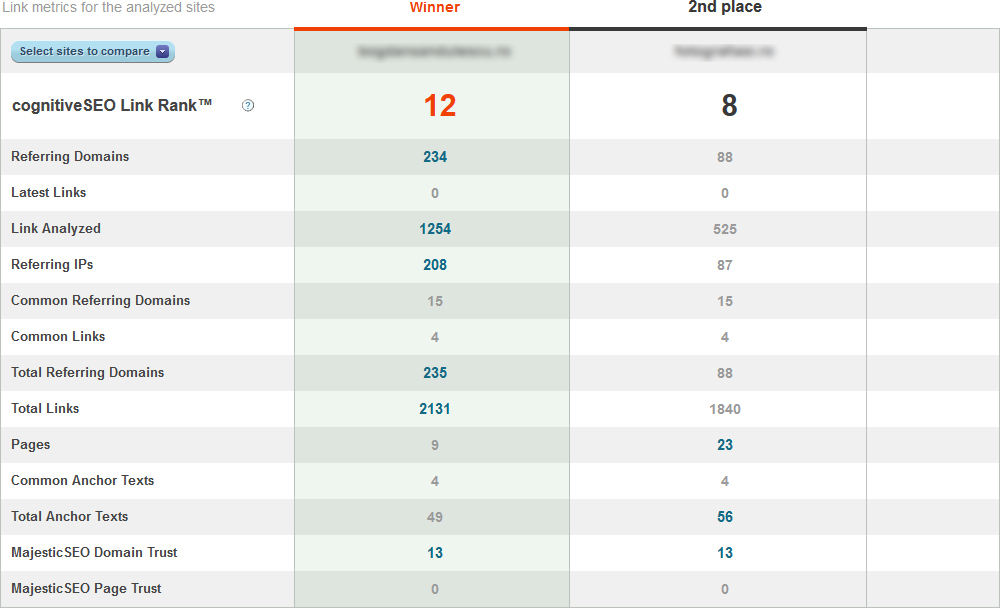 The decision about the winner site, second place and so on is taken by comparing link ranks. If you want you can change the calculus formula for the link rank. Once you apply the new formula, the link rank will be recalculated for all sites analyzed.
The decision about the winner site, second place and so on is taken by comparing link ranks. If you want you can change the calculus formula for the link rank. Once you apply the new formula, the link rank will be recalculated for all sites analyzed.
At mouse over you can see a short explanation of this concept: “CognitiveSEO Link Rank is calculated based on a formula that takes into consideration multiple internal and external factors by applying a certain influence on each metric. You can customize this formula in the Competitive Link Analysis area.”
Link Charts & Profiles
Link History By
The Link History By metric provides the number of new links/month since the beginning of the sites. The data for all sites is displayed in the same graphic. Each site has a different color so you can identify it easily.
The timeline at the right shows new links and lost links for the analyzed links (domains) on a daily basis, since the beginning of the campaign. Every 2-3 days the system is updated. The new data is viewable in the table and on the timeline.
Common Dialog Options
 Also available on Onetime Snapshot campaigns.
Also available on Onetime Snapshot campaigns.
The graphic includes two charts for each site:
- Link velocity since the beginning of the site
- New links and referring domains that appear on a monthly basis.
This chart is non-cumulative.
In Analyzed Links the chart is the cumulative total number of analyzed links per referring domain existing into the system. This graphic starts at the campaign creation time, and there is no history for it.
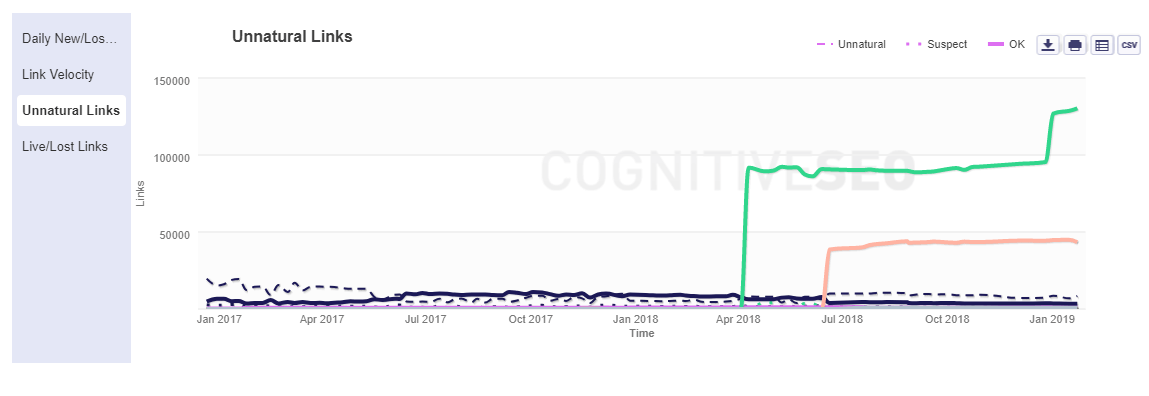 This is a very important chart in your analysis. Here you can see the natural and unnatural links evolution into the system, and with the help of this graphic, you can protect your domain from negative SEO, or you can manage the risk of being penalized by Google due to unnatural links that you have. All graphics in the Cognitive SEO system, except for Daily New Lost Links and Link Velocity are updated weekly , at campaign reruns.
This is a very important chart in your analysis. Here you can see the natural and unnatural links evolution into the system, and with the help of this graphic, you can protect your domain from negative SEO, or you can manage the risk of being penalized by Google due to unnatural links that you have. All graphics in the Cognitive SEO system, except for Daily New Lost Links and Link Velocity are updated weekly , at campaign reruns.
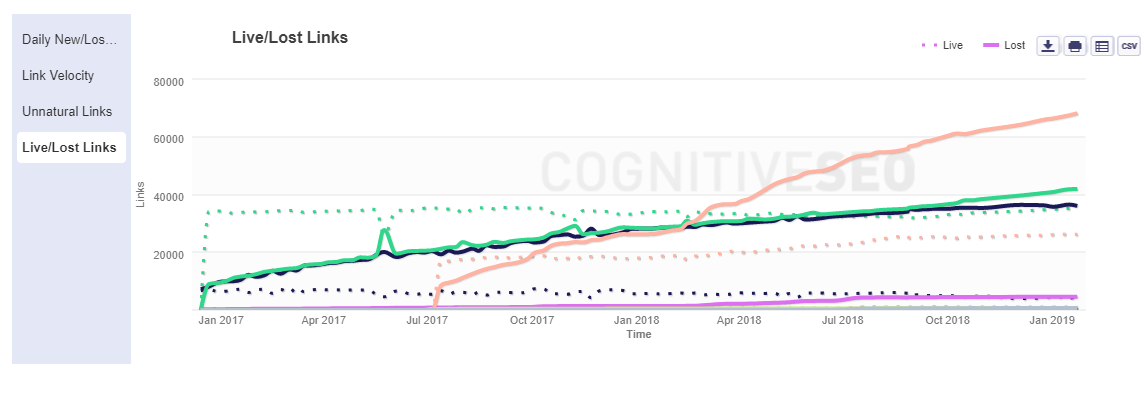 One graphic represents the number of live links, and the other one the number of lost links and how they’ve been evolving since you started the campaign.
One graphic represents the number of live links, and the other one the number of lost links and how they’ve been evolving since you started the campaign.
If you didn’t classify the links as brand versus commercial on every site you want to analyze, in the individual inbound link analysis, a notification will be displayed in this area. You must perform the individual link classification in order to be able to see the complete comparison.
Brand vs. Commercial Anchor Text Distribution
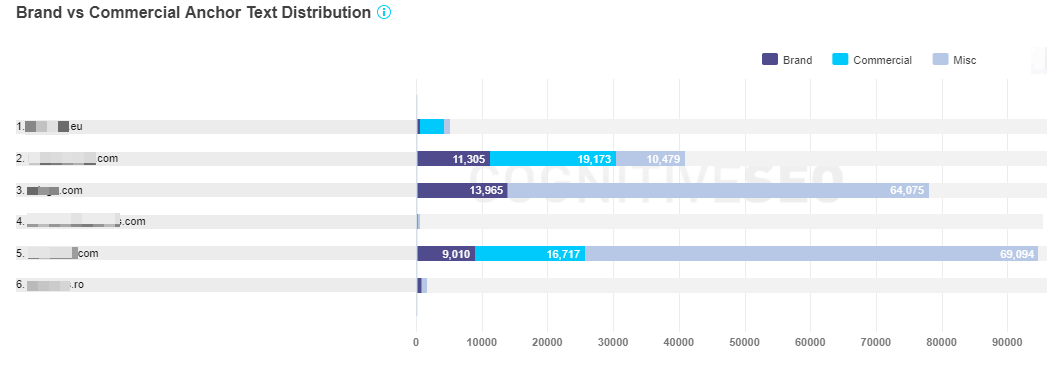 In this chart the commercial versus brand anchor text distribution is compared for the analyzed sites. If for one or more sites the anchor text was not defined, a warning is displayed: “Incomplete data! You need to define your brand and commercial keywords for the following sites:…”
In this chart the commercial versus brand anchor text distribution is compared for the analyzed sites. If for one or more sites the anchor text was not defined, a warning is displayed: “Incomplete data! You need to define your brand and commercial keywords for the following sites:…”
 In yellow background the system marks common anchor text keywords. When you click on one keyword a pop-up displays all links that contain the selected anchor text.
In yellow background the system marks common anchor text keywords. When you click on one keyword a pop-up displays all links that contain the selected anchor text.
Anchor Text Distribution – you can select only anchor text that is common to any 2 sites, common to any 3 sites, 4 sites and so on.
The non-common anchor text is displayed in the corresponding site color.
Referring IPs vs. Referring Domains vs. Links
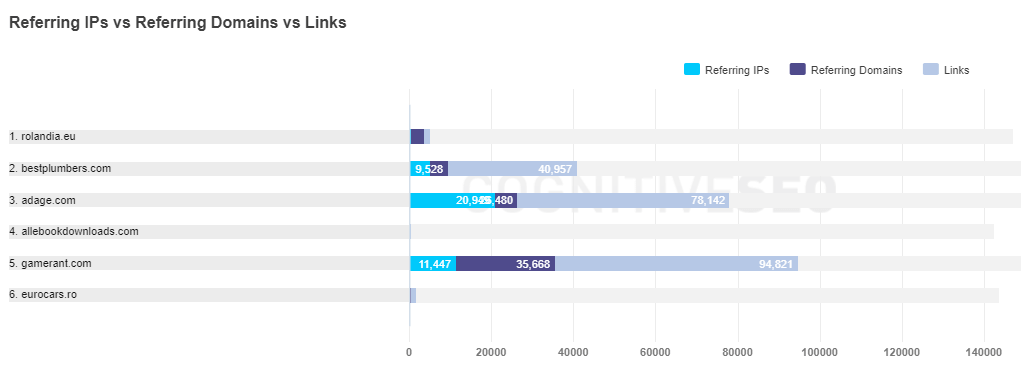 Compares all three metrics for each site.
Compares all three metrics for each site.
Following some communality traces are shown for comparison:
- Common Links
- Common Domains
-
Common IPs
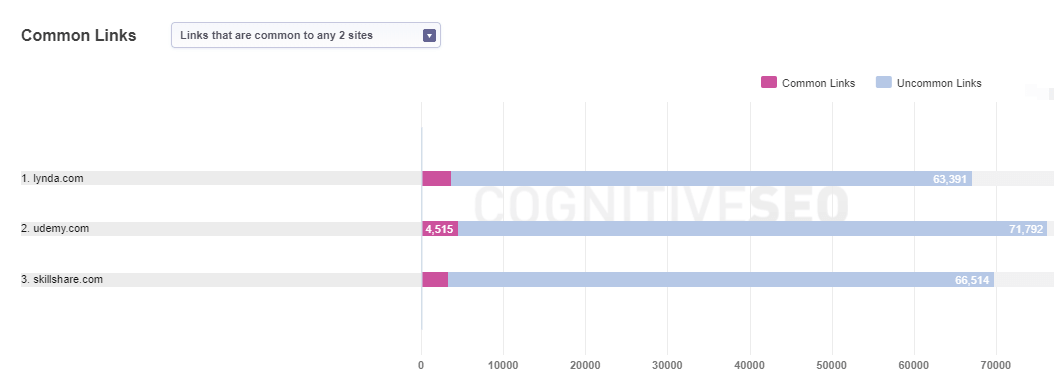 This metric displays the links that point to all compared sites.
This metric displays the links that point to all compared sites.
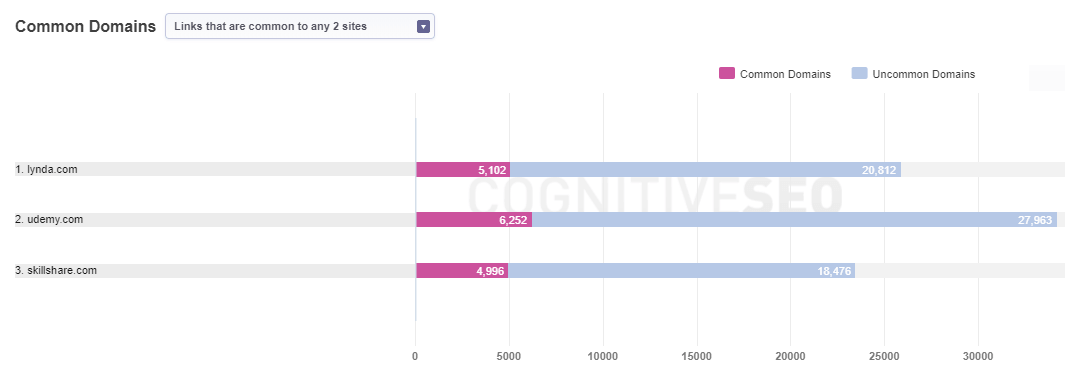 This metric displays the domains that point to all compared sites.
This metric displays the domains that point to all compared sites.
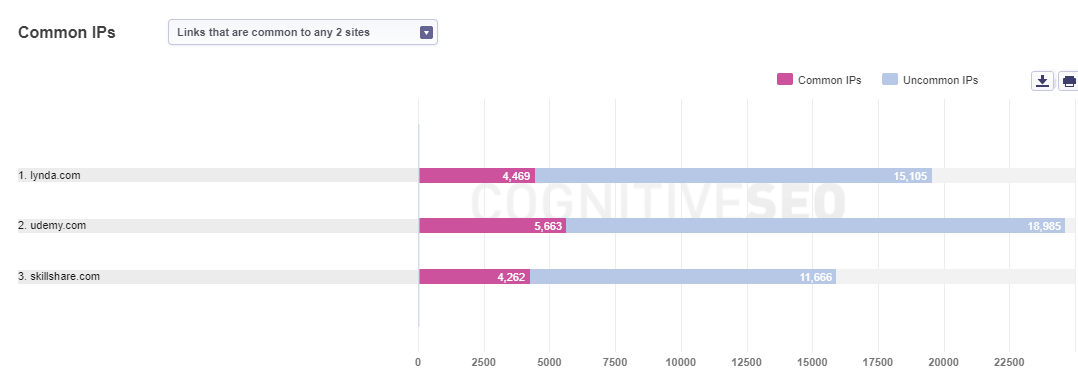 You can also compare sites two by two or all at once. When you click on a common link/domain/IP in any of these graphics, a pop-up opens with all common links/domains/IPs:
You can also compare sites two by two or all at once. When you click on a common link/domain/IP in any of these graphics, a pop-up opens with all common links/domains/IPs:
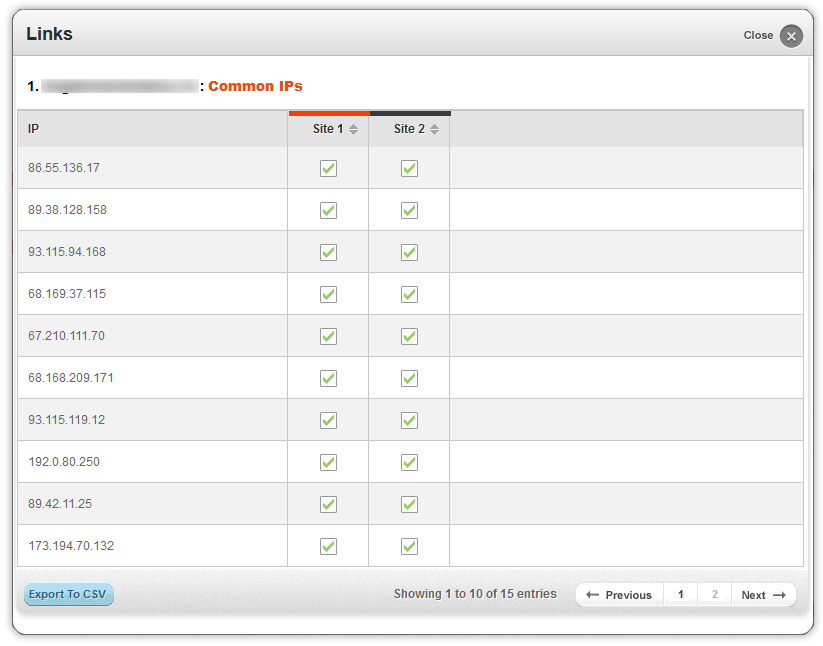 These links are important when you want to see what links your competitors have and you don’t and vice-versa.
These links are important when you want to see what links your competitors have and you don’t and vice-versa.
Link Influence is a crowd sourced metric giving you an overall information about the Authority of a linking page. It is calculated using multiple other metrics and gives a result that matches one of the 4 types of Influence (High/Good/Low/No). It is natural to have a high distribution of Low and No authority linking pages , because the web is formed of a very high distribution of low quality pages.
This metric does not reflect the naturalness of a link.
This metric aggregates data from various data providers. Based on our formula and on those metrics we obtain the CognitiveSEO Link Authority score. At click on the ring slices the corresponding links in the selected category will open.
In the Competitive Link Analysis view this metric is presented as a bar chart for each site analyzed.
A metric similar with CognitiveSEO Link Authority is used to analyze the Authority of a linking domain.
This is a crowd sourced metric giving you an overall information about the Influence of a linking domain. It is calculated using multiple other metrics and gives a result that matches one of the 4 types of Influence (High/Good/Low/No). It is natural to have a high distribution of Low and No authority linking domains, because the web is formed of a very high distribution of low-quality domains.
In the Competitive Link Analysis view this metric is presented as a bar chart for each analyzed site.
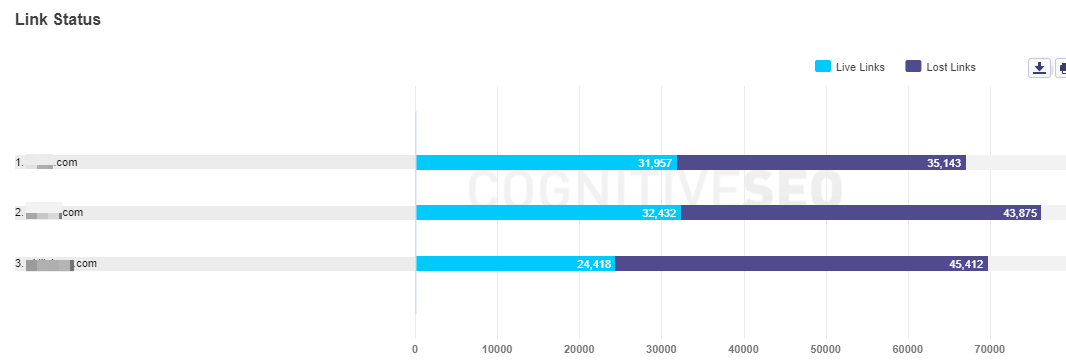 For each site there is a bar chart that displays the live links versus lost (broken) links.
For each site there is a bar chart that displays the live links versus lost (broken) links.
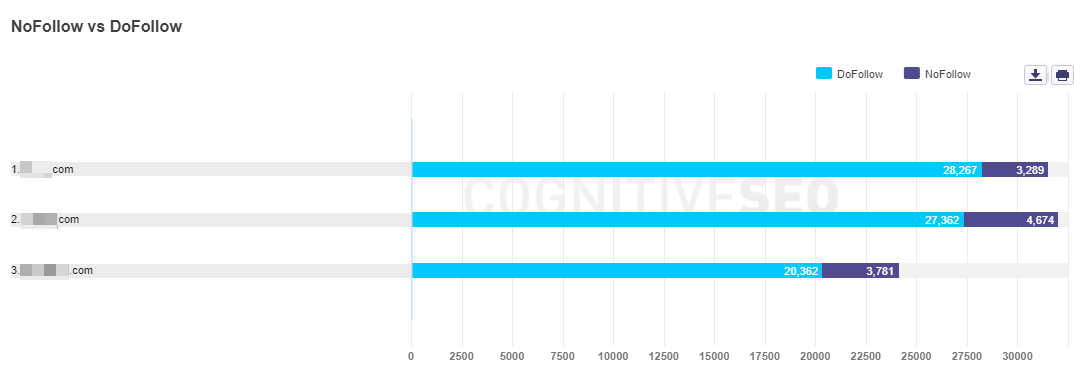 For each site there is a bar chart displaying the no follow vs. the do follow links.
For each site there is a bar chart displaying the no follow vs. the do follow links.
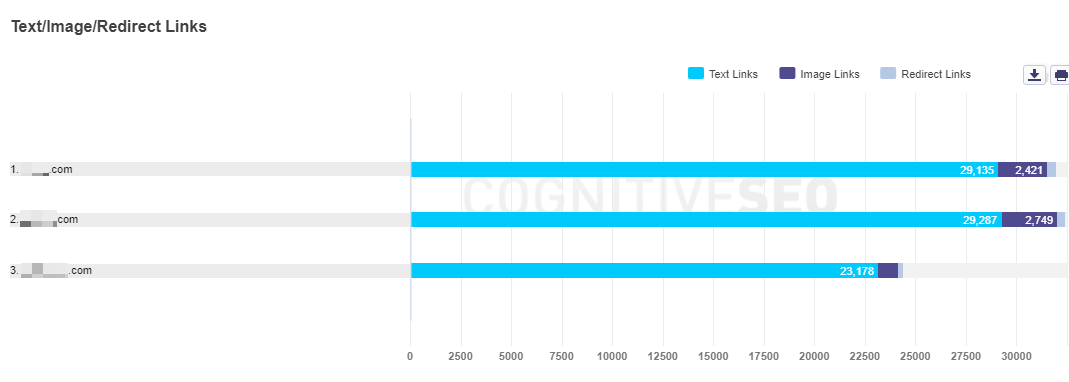 For each site, a bar chart displays the number of text links (normal, anchor text links), image links, and redirect links to your site from the total number of links.
For each site, a bar chart displays the number of text links (normal, anchor text links), image links, and redirect links to your site from the total number of links.
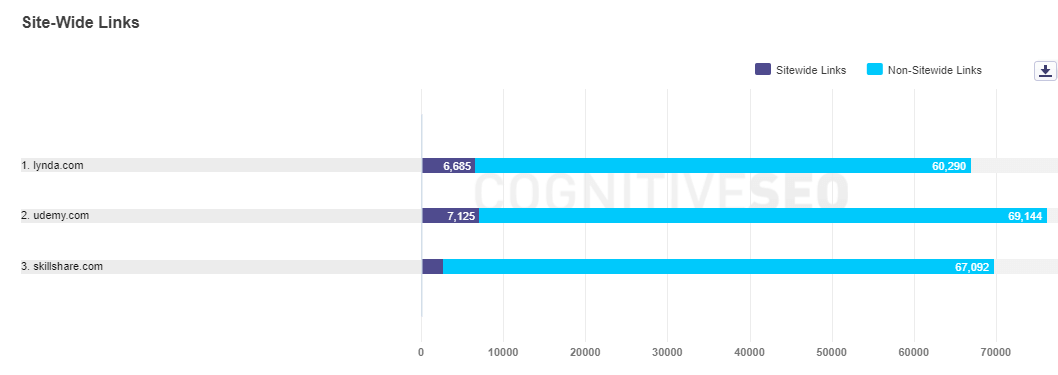 Site wide links are replicated on several (or all) pages of your site. For example the footer or blog-roll links are site-wide links.
Site wide links are replicated on several (or all) pages of your site. For example the footer or blog-roll links are site-wide links.
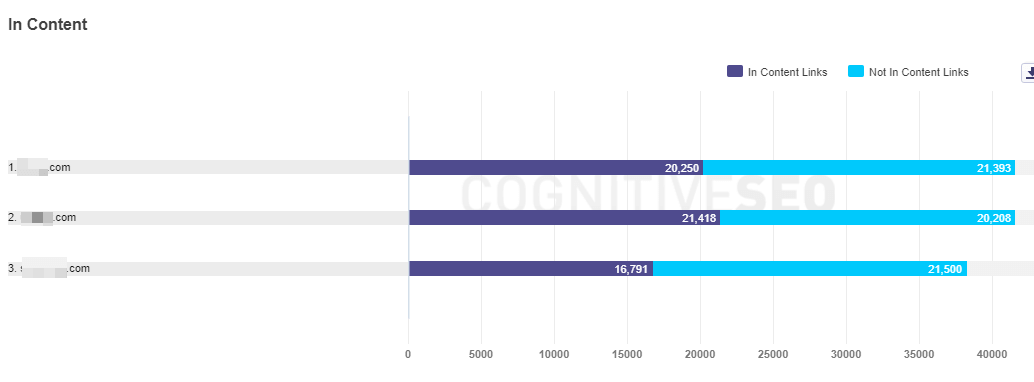 For each site there is a bar chart that displays the ratio of links that appear in content, versus the links that are separated from the content of a page (for example a link that appears in a group of links).
For each site there is a bar chart that displays the ratio of links that appear in content, versus the links that are separated from the content of a page (for example a link that appears in a group of links).
 This chart classifies the links by their anchor target for each analyzed site.
This chart classifies the links by their anchor target for each analyzed site.
 For each analyzed site there is a bar chart displaying from which countries come the IPs that send them the most links.
For each analyzed site there is a bar chart displaying from which countries come the IPs that send them the most links.
Deep Link Ratio
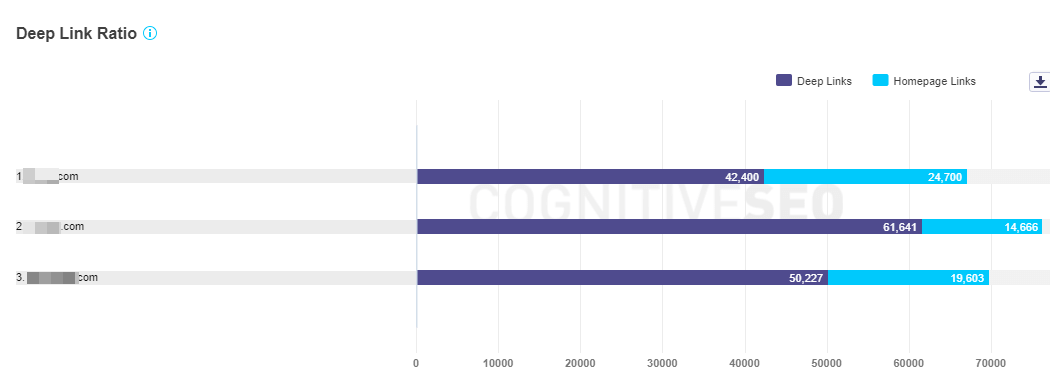 Deep link ratio is the percent of backlinks (or inbound links) that point at pages other than your own homepage. Examples:
Deep link ratio is the percent of backlinks (or inbound links) that point at pages other than your own homepage. Examples:
a.com -> b.com/test.html is considered a deep link.
a.com/long/link.htm -> b.com/online/line.html is considered a deep link.
a.com/long/link.htm -> b.com/index.html is considered a Homepage link.
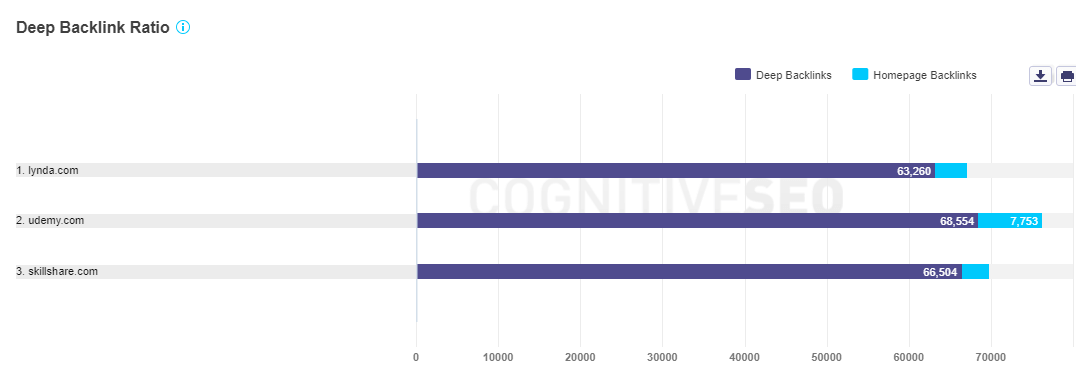 Deep backlink ratio is the percentage of backlinks or inbound links coming from deep pages vs. backlinks coming from root pages. Examples:
Deep backlink ratio is the percentage of backlinks or inbound links coming from deep pages vs. backlinks coming from root pages. Examples:
a.com -> b.com/test.html is considered a homepage backlink.
a.com/long/link.htm -> b.com/online/line.html is considered a deep backlink.
a.com/long/link.htm -> b.com/index.html is considered a deep backlink.
 From this chart you can figure out what is the main strategy the compared sites use to get links: web directories, blogs, forums, articles etc.
From this chart you can figure out what is the main strategy the compared sites use to get links: web directories, blogs, forums, articles etc.
 This metric shows with more accuracy where the link is placed on the page.
This metric shows with more accuracy where the link is placed on the page.
 There are three categories of where the links come from, from a webpage area point of view : Body, footer, header, with footer links being the least visible.
There are three categories of where the links come from, from a webpage area point of view : Body, footer, header, with footer links being the least visible.
 The website contents are classified in 19 categories and in this graphic you can see how links are distributed based on these categories for the compared sites. This is a metric that may also help you identify unnatural links, based on those categories.
The website contents are classified in 19 categories and in this graphic you can see how links are distributed based on these categories for the compared sites. This is a metric that may also help you identify unnatural links, based on those categories.
 This chart displays in comparison how links are distributed based on the language of the pages that the links come from. In this case, you may identify unnatural links by the language of the page they come from. If it’s a language that is less likely to be spoken by those who visit your site, then maybe you should rethink your strategy.
This chart displays in comparison how links are distributed based on the language of the pages that the links come from. In this case, you may identify unnatural links by the language of the page they come from. If it’s a language that is less likely to be spoken by those who visit your site, then maybe you should rethink your strategy.
 This graphic displays in comparison how links are distributed based on their TLD names.
This graphic displays in comparison how links are distributed based on their TLD names.
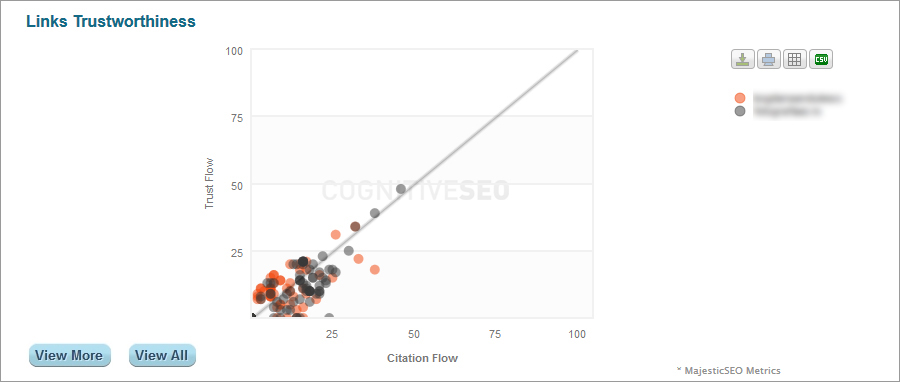 These data are provided by Majestic SEO. Majestic SEO is one of our providers and this metric is interpreted in the following way: The higher the point on the chart curve, the better the link quality, where the vertical axis represents Trust Flow and the horizontal axis represents Citation Flow.
These data are provided by Majestic SEO. Majestic SEO is one of our providers and this metric is interpreted in the following way: The higher the point on the chart curve, the better the link quality, where the vertical axis represents Trust Flow and the horizontal axis represents Citation Flow.
At mouse over on each point you can see the link name, as well as link’s Trust and Citation values.
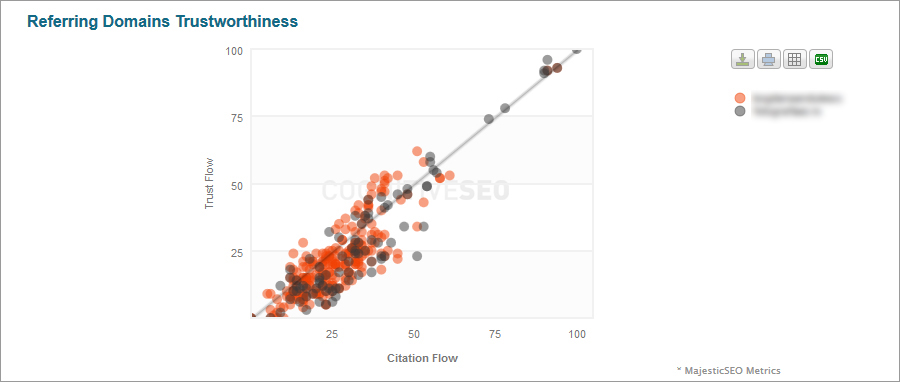 The data on this chart are interpreted similarly with those at Link Trustworthiness.
The data on this chart are interpreted similarly with those at Link Trustworthiness.
 Google PR is extracted for the home page and we can see a distribution of pr values of links pointing to our site.
Google PR is extracted for the home page and we can see a distribution of pr values of links pointing to our site.
Webpage ACRank
 This is a metric from Majectic SEO similar with Google PR.
This is a metric from Majectic SEO similar with Google PR.
 This graphic shows in comparison the links that point to the pages where we found backlinks. The larger the interval, the better for the link performance. If you click on a link that comes from a large interval category, you will see that the link comes from a page that has a high number of links pointing to it. That means having a link on that page pointing to your site is of greater value to you than having a link on a page with no links pointing to that page.
This graphic shows in comparison the links that point to the pages where we found backlinks. The larger the interval, the better for the link performance. If you click on a link that comes from a large interval category, you will see that the link comes from a page that has a high number of links pointing to it. That means having a link on that page pointing to your site is of greater value to you than having a link on a page with no links pointing to that page.
 With this metric, the exact opposite is true: the more links the sites have on a smaller interval, the better, because it represents links that point out of the sites.
With this metric, the exact opposite is true: the more links the sites have on a smaller interval, the better, because it represents links that point out of the sites.
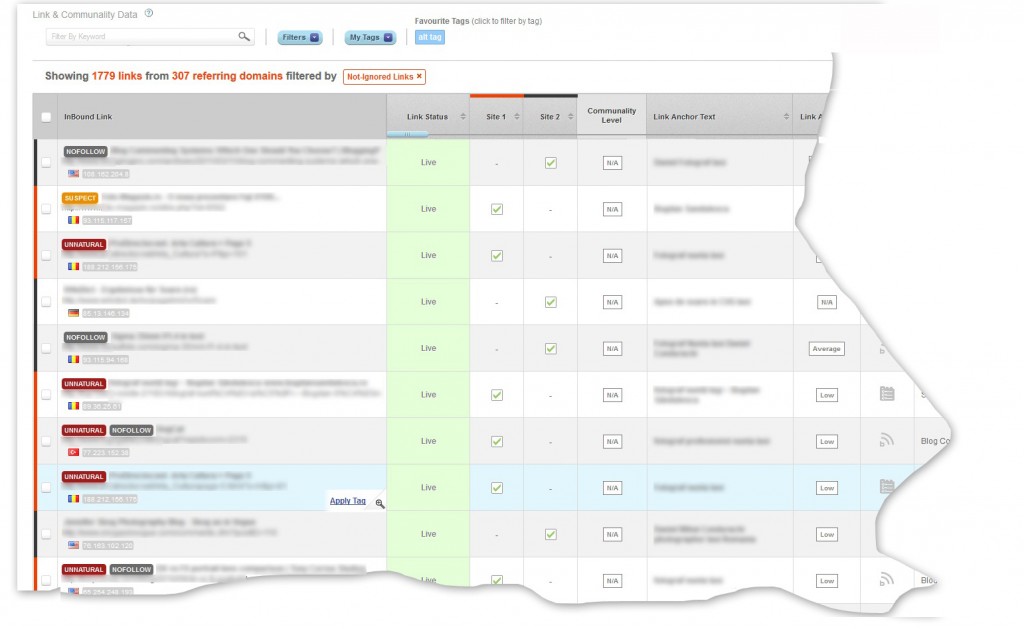 In the Data Table the system displays all links that comply with the applied filter or the user selected criteria.
In the Data Table the system displays all links that comply with the applied filter or the user selected criteria.
In the Comparison Data Table there are some options that are no longer available, for example Ignore and Disavow.
You can select which sites you want to compare, or even specific pages from different sites.
But also, the Comparison Data Table includes data that is not available in the individual data table, such as the communality columns:
- Site 1
- Site 2
- …
-
Communality Level
Data Table Options
You can choose to Show All columns in the data table or only a certain selection of them. To select/unselect columns click on each category.

